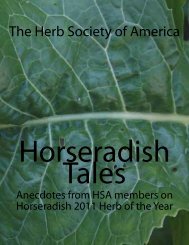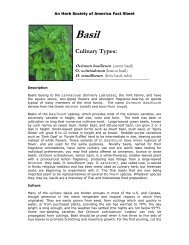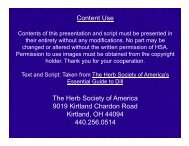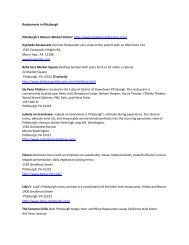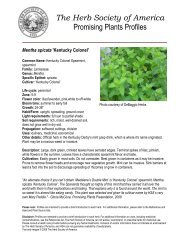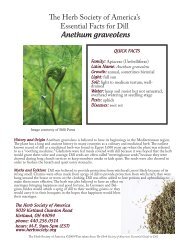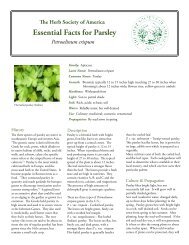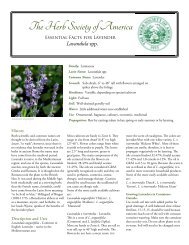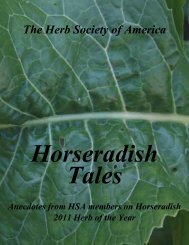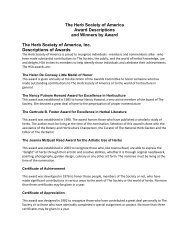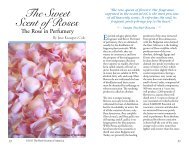Selected Early Herbal Titles in the Rare Books Collection - The Herb ...
Selected Early Herbal Titles in the Rare Books Collection - The Herb ...
Selected Early Herbal Titles in the Rare Books Collection - The Herb ...
Create successful ePaper yourself
Turn your PDF publications into a flip-book with our unique Google optimized e-Paper software.
5Text and selected images from an onl<strong>in</strong>e exhibit about a mid 18 th century herbalwritten by an English woman.Bush-Brown, Louise Carter. Men with Green Pens, Lives of <strong>the</strong> Great Writers on Plants <strong>in</strong> <strong>Early</strong>Times. Philadephia: Dorrance, 1964.Chapters on <strong>in</strong>dividual figures <strong>in</strong> <strong>the</strong> history of botanical literature, <strong>in</strong>clud<strong>in</strong>g achapter on Gerard. Also discussed, <strong>the</strong> Papyrus Ebers, <strong>The</strong>ophrastes, Dioscurides,Albertus Magnus, Bartholomaeus Anglicus, Brunfels, Fuchs, Turner, and Monardes.Includes excerpts from Gerard’s <strong><strong>Herb</strong>al</strong>. Signed by <strong>the</strong> author. QK26 .B8Cheston, Emily Read. “Elizabeth Blackwell and Her ‘Curious <strong><strong>Herb</strong>al</strong>.’” <strong>The</strong> <strong>Herb</strong>arist 1942:24-26.Blackwell’s 1737 herbal catalogues what was grow<strong>in</strong>g <strong>in</strong> London’s Apo<strong>the</strong>cariesGarden.Clarkson, Rosetta E. <strong>The</strong> Golden Age of <strong>Herb</strong>s and <strong><strong>Herb</strong>al</strong>ists. New York: Dover Publications,1972.Orig<strong>in</strong>ally published as Green Enchantment: <strong>the</strong> Magic Spell of Gardens, <strong>in</strong> 1940. Authorwas <strong>the</strong> founder of <strong>The</strong> <strong>Herb</strong> Journal. Extremely readable narrative approach to <strong>the</strong>history of European garden<strong>in</strong>g, with focus on medieval orig<strong>in</strong>s and <strong>the</strong> importanceof herbalism. A time l<strong>in</strong>e from 1476-1730 that places significant historical andcultural developments <strong>in</strong> context with literary figures and important gardendevelopments is a useful graphic feature. SB451 C5 1972Coll<strong>in</strong>s, M<strong>in</strong>ta. Medieval <strong><strong>Herb</strong>al</strong>s: <strong>The</strong> Illustrative Traditions. London: British Library, 2000.Cranch, Robbie L. “Dioscurides: Physician, Soldier, Botanical Genius.” <strong>The</strong> <strong>Herb</strong> Companion9.3 (Feb/Mar 1997): 64-66.About <strong>the</strong> first century Greek whose treatise De Materia Medica is one of <strong>the</strong>foundations for herbals for <strong>the</strong> next sixteen hundred years.Culpeper, Nicholas. <strong>The</strong> Complete <strong><strong>Herb</strong>al</strong>:…to Which is Now Added, Upwards of One HundredAdditional <strong>Herb</strong>s.... London: T. Kelly, [n.d.][Culpeper, Nicholas.] [<strong>The</strong> Complete <strong><strong>Herb</strong>al</strong> … to which are now first annexed <strong>the</strong> English PhysicianEnlarged and Key to Physic.][S. l.]: [n. d.].
6Culpeper, Nicholas. Culpeper's Complete <strong><strong>Herb</strong>al</strong>: Consist<strong>in</strong>g of a Comprehensive Description of NearlyAll <strong>Herb</strong>s with <strong>the</strong>ir Medic<strong>in</strong>al Properties and Directions for Compound<strong>in</strong>g <strong>the</strong> Medic<strong>in</strong>esExtracted From <strong>The</strong>m. London: W. Foulsham and Co., Ltd., [n. d.].This undated item is a modern repr<strong>in</strong>t of a n<strong>in</strong>eteenth century edition of Culpeper’s<strong><strong>Herb</strong>al</strong> orig<strong>in</strong>ally published <strong>in</strong> 1652. Includes “Directions for Mak<strong>in</strong>g Syrups, etc.”which is a series of short chapters on <strong>the</strong> medic<strong>in</strong>al preparation of <strong>the</strong>se herbs,author uncerta<strong>in</strong>. Includes an <strong>in</strong>dex of “All Human Diseases and <strong>the</strong> Names of <strong>the</strong><strong>Herb</strong>s that Will Cure <strong>The</strong>m…<strong>the</strong> Whole Be<strong>in</strong>g a Complete Guide to Culpeper’s<strong><strong>Herb</strong>al</strong>,” which does not seem to be part of Culpeper’s orig<strong>in</strong>al. RS164 .C8Culpepper [sic], Nicholas. <strong>The</strong> English Physician Enlarged; Conta<strong>in</strong><strong>in</strong>g Three Hundred and Sixty-n<strong>in</strong>eReceipts for Medic<strong>in</strong>es Made from <strong>Herb</strong>s. Taunton, MA: S. W. Mortimer, 1826.In 1652 Culpeper published <strong>The</strong> English Physician Enlarged, or, <strong>the</strong> <strong><strong>Herb</strong>al</strong>. This 1652edition which espoused his <strong>the</strong>ory of <strong>the</strong> relationship between astrology and herbsand physical health found enormous popularity, and ultimately controversy, for itsauthor. Many editions of <strong>the</strong> English Physician, also called <strong>The</strong> <strong><strong>Herb</strong>al</strong>, or Culpeper’s<strong><strong>Herb</strong>al</strong>, were ultimately published and this cont<strong>in</strong>ues to <strong>the</strong> present day, with a strong<strong>in</strong>terest <strong>in</strong> Culpeper’s work <strong>in</strong> <strong>the</strong> herbal community. <strong>The</strong> orig<strong>in</strong>al 1652 edition wasnot illustrated, but later editions featured added illustrations. <strong>The</strong> <strong>Herb</strong> Society hadfour later editions of this work. <strong>The</strong> earliest <strong>in</strong> our collection dates to 1792, andano<strong>the</strong>r is securely dated to 1826, an American edition. We also have an editionwhich dates probably to <strong>the</strong> mid-n<strong>in</strong>eteenth century. One of our editions is miss<strong>in</strong>g atitle page, but it is clearly Culpeper’s <strong><strong>Herb</strong>al</strong>, and dates on <strong>the</strong> illustrations suggest itcould be no earlier than 1809.Culpeper, Nicholas. “<strong>The</strong> English Physitian, Nicholas Culpeper, 1616-1654”. <strong>The</strong> ColonialGazette. MayflowerFamilies.com, 2000. Onl<strong>in</strong>e athttp://www.mayflowerfamilies.com/enquirer/nicholas_culpeper.htm .Brief onl<strong>in</strong>e excerpts from Culpeper’s English Physician’s descriptions of seventeenherbs.Culpeper, Nicholas. Pharmacopoeia Lond<strong>in</strong>ensis, or, <strong>The</strong> London dispensatory fur<strong>the</strong>r adorned by <strong>the</strong>studies and collections of <strong>the</strong> fellows now liv<strong>in</strong>g, of <strong>the</strong> said colledge .... London: G. Sawbridge,1675.In 1649, Nicholas Culpeper enraged <strong>the</strong> London College of Surgeons by dar<strong>in</strong>g totranslate, edit, and annotate <strong>the</strong>ir magisterial and authoritative text, <strong>the</strong> LondonPharmacopoeia, from Lat<strong>in</strong> <strong>in</strong>to English, with <strong>the</strong> <strong>in</strong>tention that this knowledge ofmedic<strong>in</strong>e should be made more widely accessible to <strong>the</strong> common person. Thiscommitment to popularize medic<strong>in</strong>al knowledge was one of <strong>the</strong> keynotes ofCulpeper’s career. <strong>The</strong> <strong>Herb</strong> Society holds this 1675 edition of <strong>the</strong> Pharmacopoeia.
7Culpeper, Nicholas, and Mrs. C. F. Leyel. Culpeper’s English Physician and Complete <strong><strong>Herb</strong>al</strong>.London: <strong>Herb</strong>ert Joseph Ltd., 1947.“Arranged for Use as a First Aid <strong><strong>Herb</strong>al</strong> by Mrs. C.F. Leyel.” A selection of entriesfrom Culpeper’s work, to which Mrs. Leyel adds identification of <strong>the</strong> correctbotanical names and orders, and annotations on “modern” medical use. Includesbotanical and cl<strong>in</strong>ical <strong>in</strong>dexes, and a brief biographical essay on Culpeper. RS81 .C91947.Culpeper, Nicholas, and David Potterton, ed. Culpeper’s Color <strong><strong>Herb</strong>al</strong>. New York: Sterl<strong>in</strong>gPublish<strong>in</strong>g, Inc., 1983.<strong>The</strong> entries from Culpeper’s <strong><strong>Herb</strong>al</strong> are presented as orig<strong>in</strong>ally, with description of<strong>the</strong> herb, where it grows, flower<strong>in</strong>g times, astrological sign, and “medic<strong>in</strong>al virtues,”but <strong>the</strong> editor Potterson augments <strong>the</strong> entries with modern annotations andrecommendations on contemporary medic<strong>in</strong>al uses of <strong>the</strong> <strong>in</strong>dividual herbs. <strong>The</strong>illustrations have been colored, and botanical names added for each specimen. An<strong>in</strong>troductory essay by E. J. Shellard places Culpeper’s career with<strong>in</strong> <strong>the</strong> historicalcontext of economic and social change <strong>in</strong> <strong>the</strong> late 17 th century, and expla<strong>in</strong>sCulpeper’s system of relat<strong>in</strong>g <strong>the</strong> uses of herbs to astrology. Includes a glossary, and<strong>in</strong>dexes to herbs and <strong>the</strong>ir medic<strong>in</strong>al uses both for Culpeper’s usage and forcontemporary usage. RS164 .C85.Culpeper, Nicholas and Ebenezer Sibley. Culpeper's English physician: and complete herbal. Towhich are now first added, upwards of one hundred additional herbs ... Form<strong>in</strong>g a complete familydispensatory, and natural system of physic. Beautified and enriched with engrav<strong>in</strong>gs ... Illustratedwith notes and observations .... London: Pr<strong>in</strong>ted for <strong>the</strong> author, and sold at <strong>the</strong> BritishDirectory Office; and by Champante and Whitrow, 1794.Department of Horticulture and Crop Science. “History of Horticulture.” WebGarden,Horticulture and Crop Science <strong>in</strong> Virtual Perspective. Columbus, OH: <strong>The</strong> Ohio StateUniversity, 2003. Onl<strong>in</strong>e at http://www.hcs.ohio-state.edu/hort/12to1.html .This is a database of brief biographies and discussion of major figures <strong>in</strong> <strong>the</strong> writ<strong>in</strong>gof <strong>the</strong> history of horticulture from Classical Antiquity to <strong>the</strong> present. Very useful tofamiliarize <strong>the</strong> researcher with <strong>the</strong> major literary figures <strong>in</strong> garden<strong>in</strong>g.Dille, Carolyn, and Michael Dille. “ Notes Toward a Modern <strong><strong>Herb</strong>al</strong>.” <strong>The</strong> <strong>Herb</strong> Companion4.3 (Feb/Mar 1992): 78-80.Gently humorous look at a modern herbal of yet-to-be-discovered species such as“dilldock”, “furbal” and “katterwaller.”
8Dioscurides Pedanius of Anazarbos, John Goodyer, and R. T. Gun<strong>the</strong>r. <strong>The</strong> Greek <strong><strong>Herb</strong>al</strong> ofDioscurides. New York: Hafner Publish<strong>in</strong>g Co., 1968.This is a facsimile of <strong>the</strong> 1934 edition of Gun<strong>the</strong>r’s title. This book publishes <strong>the</strong>1655 English translation, by John Goodyer, of <strong>the</strong> Greek Dioscurides text from <strong>the</strong>first century, with illustrations from a Byzant<strong>in</strong>e artist work<strong>in</strong>g <strong>in</strong> 512 A.D.Goodyer’s manuscript was never pr<strong>in</strong>ted. Gun<strong>the</strong>r <strong>in</strong>cludes <strong>the</strong> text from <strong>the</strong> 17 thcentury, largely unedited, and l<strong>in</strong>e draw<strong>in</strong>gs which transcribe <strong>the</strong> orig<strong>in</strong>al art work.Dioscurides catalogs and prescribes <strong>the</strong> uses not only for herb, but for materialmedica of liv<strong>in</strong>g creatures, m<strong>in</strong>eral, animal products, aromatics, oils, o<strong>in</strong>tments, andtrees. Dioscurides work is considered to be <strong>the</strong> major source for most Europeanherbals throughout <strong>the</strong> middle ages and <strong>the</strong> Renaissance and beyond. <strong>The</strong> appendixpresents a 1857 attempt to systematize <strong>the</strong> species featured <strong>in</strong> <strong>the</strong> text accord<strong>in</strong>g to<strong>the</strong> L<strong>in</strong>naean system. Both a 1655 Lat<strong>in</strong> <strong>in</strong>dex and a contemporary supplemental<strong>in</strong>dex are <strong>in</strong>cluded. . R126 .D65Elliott, Brent. “17 th Century Progress.” <strong>The</strong> Garden 120.6 (June 1995): 340-343.History of botanical illustration, herbals, and florilegia.Elliott, Brent. “4oo Years of Gerard’s <strong><strong>Herb</strong>al</strong>l.” <strong>The</strong> Garden 122.11 (Nov 1997): 793-795.<strong>The</strong> rise, fall and resurrection of <strong>the</strong> classic work by John Gerard.Elliott, Brent. “<strong>The</strong> Birth of Botanical Illustrations.” <strong>The</strong> Garden 120.2 (Feb 1995): 81-83.Discussion of <strong>the</strong> purpose of early botanical illustration, illustrators, problems andachievements, different clients, color reproductions, natural style, draw<strong>in</strong>g to fit, andearly herbals.Elliott, Brent. “<strong>The</strong> Florilegium.” <strong>The</strong> Garden 120:4 Apr. 1995: 204.Discusses improvements to quality of botanical illustrations after <strong>the</strong> <strong>in</strong>troduction ofengrav<strong>in</strong>g technology <strong>in</strong> <strong>the</strong> 17 th century. Includes a chronology of <strong>the</strong> majorflorilegia.Emmart, Emily Walcott. <strong>The</strong> Badianus Manuscript; (Codex Barber<strong>in</strong>i, Lat<strong>in</strong> 241) Vatican Library;An Aztec <strong><strong>Herb</strong>al</strong> of 1552. Baltimore: <strong>The</strong> John Hopk<strong>in</strong>s Press, 1940.<strong>The</strong> <strong>Herb</strong> Society has three copies of this facsimile edition <strong>in</strong> its <strong>Rare</strong> <strong>Books</strong><strong>Collection</strong>. Foreword by Henry E. Sigerist. One copy is <strong>in</strong>scribed by <strong>the</strong> author:
9“It is a satisfaction to recall that <strong>the</strong> <strong>Herb</strong> Society of America was <strong>the</strong> firstto offer assistance <strong>in</strong> <strong>the</strong> publication of this earliest herbal of <strong>the</strong> NewWorld. I shall always be grateful to my fellow members for <strong>the</strong>irsusta<strong>in</strong><strong>in</strong>g faith dur<strong>in</strong>g <strong>the</strong> long years this volume was <strong>in</strong> preparation.Emily W. Emmart Trueblood, May 1966.”<strong>The</strong> “Liber de medic<strong>in</strong>alibus <strong>in</strong>dorum herbis” had been <strong>in</strong> <strong>the</strong> Vatican’s collectionfor almost four hundred years before Emmart published this color facsimile of anearly Aztec herbal. <strong>The</strong> text was orig<strong>in</strong>ally <strong>in</strong> <strong>the</strong> Aztec language and was translated<strong>in</strong>to Lat<strong>in</strong>. <strong>The</strong> rich, comprehensive accompany<strong>in</strong>g text puts <strong>the</strong> work <strong>in</strong>to historicalcontext, discusses <strong>the</strong> difficulties of deal<strong>in</strong>g with <strong>the</strong> Aztec language, and analyzes <strong>the</strong>text and illustrations. <strong>The</strong>re are chapters on <strong>the</strong> illustrations as pa<strong>in</strong>t<strong>in</strong>g, onmythology and medic<strong>in</strong>e <strong>in</strong> Aztec culture, and on <strong>the</strong> material medica of <strong>the</strong> Aztec.Emmart also <strong>in</strong>cludes a transcription and a translation of <strong>the</strong> orig<strong>in</strong>al, which <strong>in</strong>cludesnotes and cross references. <strong>The</strong> species <strong>in</strong>cluded are <strong>in</strong>dexed <strong>in</strong> both Aztec andbotanical Lat<strong>in</strong>.Etty, Thomas. “Gardener’s Notebook: Medieval Vegetables.” Gardens Illustrated 40 (Mar1999): 11.Heirloom vegetables and herb known to have been grown from <strong>the</strong> Middle Agesthrough <strong>the</strong> 19 th century.Fisch, Ruth B, and Max H. Fisch. “<strong>The</strong> Marshall <strong>Collection</strong> of <strong><strong>Herb</strong>al</strong>s <strong>in</strong> <strong>the</strong> ClevelandMedical Library.” Bullet<strong>in</strong> of <strong>the</strong> History of Medic<strong>in</strong>e. 21 (1947): 224-261.Foster, Steven. “America’s First <strong><strong>Herb</strong>al</strong>: <strong>The</strong> Badianus Manuscript.” <strong>The</strong> <strong>Herb</strong> Companion 7.1(Oct/Nov 1994): 27-33.Aztec herbal from 1552.Foster, Steven. “Medieval <strong><strong>Herb</strong>al</strong>s and <strong><strong>Herb</strong>al</strong>ism: Records and Practices of <strong>the</strong> MiddleAges.” <strong>The</strong> <strong>Herb</strong> Companion 3.2 (Dec-Jan 1991): 24-27.Foster, Steven. “Of <strong>the</strong> Signatures of Plants.” <strong>The</strong> <strong>Herb</strong> Companion 4.1 (Oct/Nov 1991): 26-29.Ancient and Medieval doctr<strong>in</strong>e that plants with heal<strong>in</strong>g properties will reveal <strong>the</strong>iruse through “signatures,” or some resemblance to <strong>the</strong> part of that body that <strong>the</strong>y willeffectively treat.French, R. K., and Frank Greenaway. Science <strong>in</strong> <strong>the</strong> <strong>Early</strong> Roman Empire: Pl<strong>in</strong>y <strong>the</strong> Elder, HisSources and Influence. London: Croom Helm, 1986.
10Fuchs, Leonhart. <strong>The</strong> New <strong><strong>Herb</strong>al</strong> of 1543, New Kreüterbuch. Cologne: Taschen, 2001.This title is a reproduction of Fuchs’ New Kreüterbuch, <strong>the</strong> German translation andrepublication of Fuchs’ De Historia Stirpium from 1542. While <strong>the</strong> New <strong><strong>Herb</strong>al</strong> is not atitle <strong>in</strong> <strong>the</strong> collection here at <strong>The</strong> <strong>Herb</strong> Society of America, it is a significant title <strong>in</strong>this genre, and is represented by orig<strong>in</strong>als <strong>in</strong> <strong>the</strong> Allen Memorial Medical Library at<strong>the</strong> Cleveland Medical Library Association, and at <strong>the</strong> library of <strong>the</strong> Garden Centerof Greater Cleveland. This reproduction edition gives <strong>the</strong> user at <strong>the</strong> HSA library andopportunity to look at a very important herbal title alongside <strong>the</strong> titles at <strong>the</strong> HSA.Includes an <strong>in</strong>troductory biographical essay on Fuchs and his career, “LeonhartFuchs—Physician and Pioneer of Modern Botany” by Klaus Dobat. WernerDressendörfer contributes an essay that expla<strong>in</strong>s <strong>the</strong> structure and <strong>the</strong>mes of <strong>the</strong>title’s textual content, “’Beggar’s Lice’ and ‘Miracle Tree’, On <strong>the</strong> Plants of <strong>the</strong> NewKreüterbuch.” He also provides brief notes on each chapter and names each specimenfeatured us<strong>in</strong>g <strong>the</strong> common name. In a second brief essay he mentions <strong>the</strong>dist<strong>in</strong>ctions between historical and current medical applications of many of <strong>the</strong>seherbs and provides a list of species that are used medic<strong>in</strong>ally today that are feature <strong>in</strong>Fuchs’ work. <strong>The</strong>re is also a list of Lat<strong>in</strong> and English plant names arranged accord<strong>in</strong>gto plate number and order of appearance <strong>in</strong> <strong>the</strong> text. This reproduction is taken fromFuchs’ own work<strong>in</strong>g copy. Bibliography, predom<strong>in</strong>antly German sources. QK41.F83 N49 2001Gerarde, John, and Thomas Johnson. <strong>The</strong> <strong><strong>Herb</strong>al</strong>l, or, Generall History of Plantes, Ga<strong>the</strong>red by JohnGerarde of London, Master <strong>in</strong> Chirurgerie; Very Much Enlarged and Amended by ThomasJohnson, Citizen and Apo<strong>the</strong>carye of London. London: Pr<strong>in</strong>ted by Adam Islip, JoiceNorton, and Richard Whitakers, 1633.<strong>The</strong> <strong>Herb</strong> Society of America has two copies of <strong>the</strong> early 1633 edition of Gerard’s<strong><strong>Herb</strong>al</strong>l <strong>in</strong> <strong>the</strong> <strong>Rare</strong> <strong>Books</strong> collection, one housed at <strong>the</strong> <strong>Rare</strong> <strong>Books</strong> Library atHolden Arboretum, and one at <strong>the</strong> headquarters of <strong>The</strong> <strong>Herb</strong> Society. Gerard’swork, orig<strong>in</strong>ally published <strong>in</strong> London <strong>in</strong> 1597 is significant as <strong>the</strong> most popular andwell known pr<strong>in</strong>ted English herbal. It was part of <strong>the</strong> late 16 th century developmentof herbals <strong>in</strong> <strong>the</strong> vernacular throughout Europe. Gerard’s text was based upon atranslation of an earlier Lat<strong>in</strong> herbal by <strong>the</strong> Flemish herbalist Dodoen from 1583. In1633, Thomas Johnson edited <strong>the</strong> orig<strong>in</strong>al text for mistakes, and added his ownentries, commentary and observations, plus some 700 additional illustrations.Gerard, John, and Thomas Johnson. <strong>The</strong> <strong><strong>Herb</strong>al</strong>, or General History of Plants. New York: DoverPublications, 1975.This volume is a complete reproduction of <strong>the</strong> 1633 edition of Gerard’s <strong><strong>Herb</strong>al</strong>l ascorrected and amplified by Thomas Johnson. Includes a brief publisher’s note which<strong>in</strong>troduces <strong>the</strong> work. Complete fore and back matter is <strong>in</strong>cluded, with orig<strong>in</strong>alfrontispieces and title pages, dedication, honorary poetry dedicated to Gerard, and
11several forewords <strong>in</strong>clud<strong>in</strong>g those by Johnson and Gerard. Includes appendices and<strong>in</strong>dexes from <strong>the</strong> orig<strong>in</strong>al, among <strong>the</strong>se <strong>in</strong>dexes and a concordance of Lat<strong>in</strong> plantnames, list<strong>in</strong>gs of <strong>the</strong> British plant names, and an <strong>in</strong>dex of <strong>the</strong> uses and properties of<strong>the</strong> plants. An extremely useful volume <strong>in</strong> that one can study <strong>the</strong> orig<strong>in</strong>al materialwithout fear of damag<strong>in</strong>g and orig<strong>in</strong>al edition. <strong>The</strong> <strong>Herb</strong> Society has two copies ofthis modern re-publication <strong>in</strong> its general reference collection. QK41 .G3 1975.Gilmour, John. British Botanists. London: Coll<strong>in</strong>s, 1946.Brief coverage of <strong>the</strong> early herbalists <strong>in</strong> this history of British botanists. QK26 G5Goode, Patrick and Michael Lancaster, eds. “<strong><strong>Herb</strong>al</strong>.” <strong>The</strong> Oxford Companion to Gardens.Oxford: Oxford University Press, 1986. 249-252.This article is an excellent first choice to read <strong>the</strong> history and background ofEuropean herbals.Hall, Elizabeth C., ed. “<strong>The</strong> Old: A Garden of <strong>Herb</strong>s <strong>in</strong> <strong>the</strong> N<strong>in</strong>th Century.” <strong>The</strong> <strong>Herb</strong>arist 24(1958): 56-59.A review of Harold William Rickett’s A Garden of <strong>Herb</strong>s <strong>in</strong> <strong>the</strong> N<strong>in</strong>th Century, whichwas about <strong>the</strong> Hortulus of Strabo, a n<strong>in</strong>th century herbal poem, first <strong>in</strong> pr<strong>in</strong>t <strong>in</strong> 1510.Hayden Library, Arizona State University. <strong><strong>Herb</strong>al</strong>s and <strong>Early</strong> Garden<strong>in</strong>g <strong>Books</strong> from <strong>the</strong> Doris andMarc Patten <strong>Collection</strong>. Tempe, AZ: Arizona State University, 1997-. Onl<strong>in</strong>e athttp://www.asu.edu/lib/speccoll/patten/<strong>in</strong>dex.html .Onl<strong>in</strong>e abstracts of and images from an extensive collection of early herbal andgarden<strong>in</strong>g title <strong>in</strong> <strong>the</strong> library of Arizona State University. This is an excellent resourcefor <strong>the</strong> study of herbals.Henrey, Blanche. British Botanical and Horticultural Literature before 1800. 3 vols. London:Oxford University Press, 1975.Scholarly study and bibliography, covers works published <strong>in</strong> England, Scotland, andIreland from <strong>the</strong> 16-18 th centuries. Preface notes that titles “on <strong>the</strong> use of plants <strong>in</strong><strong>the</strong> cure of diseases are also not generally <strong>in</strong>cluded if <strong>the</strong>ir <strong>in</strong>terest is primarilymedical.” Centuries are treated separately, <strong>in</strong> each case with extensive prelim<strong>in</strong>aryhistorical and <strong>the</strong>matic essays, and <strong>the</strong>n with complete bibliographic citations to allworks pr<strong>in</strong>ted <strong>in</strong> each time period. Through <strong>in</strong>structions are given for <strong>the</strong> use of <strong>the</strong>bibliographies and <strong>the</strong>ir formats are clearly expla<strong>in</strong>ed. Each entry notes what librarieshold <strong>the</strong>se items <strong>in</strong> <strong>the</strong>ir collections. Volume One covers works from <strong>the</strong> 16-17 thcenturies and <strong>the</strong> development and history of <strong>the</strong> herbal very thoroughly, both its
12British evolution, and its relationships to cont<strong>in</strong>ental works. <strong>The</strong>se chapters areimportant for readers who want a very scholarly approach to this topic. Includes<strong>in</strong>dexes. Black and white illustrations, <strong>in</strong>clud<strong>in</strong>g reproductions of frontispieces,woodcuts, etc., from <strong>the</strong> orig<strong>in</strong>als. Some color plates <strong>in</strong> Volumes II and III on <strong>the</strong>18 th century.“<strong><strong>Herb</strong>al</strong>ist/Physician; Nicholas Culpeper. English Physician and Astrologer.” CulpepperConnections! <strong>The</strong> Culpepper Family History Site, 2003. Onl<strong>in</strong>e athttp://gen.culpepper.com/<strong>in</strong>terest<strong>in</strong>g/medic<strong>in</strong>e/nicholas.htm .A brief biography and tidbits about <strong>the</strong> herbal author, and l<strong>in</strong>ks to o<strong>the</strong>r WWW sitesof <strong>in</strong>terest on Culpeper. Also a bibliography of current editions of Culpeper’s works.<strong>The</strong> <strong>Herb</strong> Society of America. “<strong><strong>Herb</strong>al</strong> of Li Chih Chien.” <strong>The</strong> <strong>Herb</strong>arist 1938: 30-31.A one page extract from a 1596 Ch<strong>in</strong>ese herbal with a reproduction of one page ofwoodcut illustrations.<strong>The</strong> <strong>Herb</strong> Society of America. “Old <strong><strong>Herb</strong>al</strong> ‘Newe Founde.’” <strong>The</strong> <strong>Herb</strong>arist 1936: 4-8.Rediscovery of <strong>the</strong> Badianus Manuscript.<strong>The</strong> <strong>Herb</strong> Society of America. Powers and Cures; <strong>The</strong> History of Medic<strong>in</strong>al Plants. Kirtland, OH:<strong>The</strong> <strong>Herb</strong> Society of America, 1990. Slide show.This slide show (87 slides with booklet script) details <strong>the</strong> history of our knowledge ofherbal plants, us<strong>in</strong>g examples from many of <strong>the</strong> significant early herbal texts<strong>in</strong>clud<strong>in</strong>g many that are <strong>in</strong> <strong>The</strong> <strong>Herb</strong> Society’s collection. Images from many of <strong>the</strong>text pages are featured alongside images of <strong>the</strong> plants <strong>the</strong>y mention.Hildegard, Sa<strong>in</strong>t. Hildegard’s Heal<strong>in</strong>g Plants, from her Medieval Classic, “Physica.” Boston: BeaconPress, 2001.<strong>The</strong> renewal of <strong>in</strong>terest <strong>in</strong> <strong>the</strong> early scientific and mystical works of Hildegard vonB<strong>in</strong>gen prompts Bruce Hozeski to translate what amounts to a very early herbal(circa 1151-1158). This title features <strong>the</strong> first section, on plants, of Hildegard’s LiberSimplicis Medic<strong>in</strong>ae, or Physica (Book of Simple Medic<strong>in</strong>e, or, Medic<strong>in</strong>e). <strong>The</strong> Physica, part ofa larger work no longer extant, survives <strong>in</strong> several manuscript forms, and Hozewskitranslates this text from an 1882 Lat<strong>in</strong> edition published <strong>in</strong> Paris. <strong>The</strong> first book of<strong>the</strong> Physica, “Plants”, provides <strong>the</strong> text for this translation. Hildegard focuses on <strong>the</strong>properties and uses of a substantial number of plants, and not <strong>the</strong>ir identification,which makes sense given <strong>the</strong> very early time period for this book. <strong>The</strong> plants areseen with<strong>in</strong> <strong>the</strong> medieval framework of <strong>the</strong> usefulness of all of God’s creation, and
13accord<strong>in</strong>g to <strong>the</strong> medieval doctr<strong>in</strong>e of <strong>the</strong> four elements and <strong>the</strong>ir relation to health.This <strong>in</strong>cludes some <strong>in</strong>terest<strong>in</strong>g entries on gra<strong>in</strong> and legum<strong>in</strong>ous crops, and o<strong>the</strong>rnon-herbal entries such as v<strong>in</strong>egar, sugar, milk, and honey and sulphur. QK41.H55H43 2001Hocker, Sally Ha<strong>in</strong>es. <strong><strong>Herb</strong>al</strong>s and Closely Related Medico-Botanical Works, 1472-1753. Lawrence,KS: University of Kansas Libraries, 1985.This work deals with titles that are <strong>in</strong> <strong>the</strong> Special <strong>Collection</strong>s of <strong>the</strong> Clenden<strong>in</strong>gMedical Library at <strong>the</strong> University of Kansas.Hunger, F. W. T. <strong>Early</strong> <strong><strong>Herb</strong>al</strong>s from <strong>the</strong> Library of Dr. F. W. T. Hunger. Amsterdam:Internationaal Antiquariaat, 1951.Isely, Duane. One Hundred and One Botanists. Ames, IA: Iowa State University Press, 1994.Brief biographical profiles of historical botanist, from Antiquity to <strong>the</strong> 20 th century,<strong>in</strong>clud<strong>in</strong>g herbal authors Dioscurides, Hildegard of B<strong>in</strong>gen, Otto Brunfels, RembertDodoens, Gerard. Includes brief bibliographies for fur<strong>the</strong>r read<strong>in</strong>g. QK26 .I 75 1994Janick, Jules. “<strong><strong>Herb</strong>al</strong>s, <strong>the</strong> Connection Between Horticulture and Medic<strong>in</strong>e.” History ofHorticulture. West Lafayette, IN: School of Horticulture and Landscape Architecture,Purdue University, 2002. Onl<strong>in</strong>e athttp://www.hort.purdue.edu/newcrop/history/lecture23/r_23-2.html .Three extensive classroom lectures, <strong>in</strong> HTML, pdf, and PowerPo<strong>in</strong>t format, whichare part of a complete course on <strong>the</strong> history of horticulture. Special focus onDioscurides and Gerard, suggestions for fur<strong>the</strong>r read<strong>in</strong>g.Jeffers, Robert H. <strong>The</strong> Friends of John Gerard (1545-1612), Surgeon and Botanist. Falls Village, CT:<strong>The</strong> <strong>Herb</strong> Grower Press, 1967. SB63.G6 J45Johnston, Stanley H. <strong>The</strong> Cleveland <strong><strong>Herb</strong>al</strong>, Botanical, and Horticultural <strong>Collection</strong>s: A DescriptiveBibliography of Pre-1830 Works from <strong>the</strong> Libraries of <strong>the</strong> Holden Arboretum, <strong>the</strong> ClevelandMedical Library Association, and <strong>the</strong> Garden Center of Greater Cleveland. Kent, Ohio: KentState University Press, 1992.Johnston is <strong>the</strong> <strong>Rare</strong> <strong>Books</strong> Curator at <strong>the</strong> Holden Arboretum, and this enormousresource is a compilation of <strong>the</strong> bibliographical records of <strong>the</strong> early and rarevegetable, medic<strong>in</strong>al, botanical and horticultural literature at three major ClevelandInstitutions, arranged chronologically. Portions of cover titles, title pages, <strong>in</strong>cipits, orengraved titles are <strong>in</strong>cluded. An appendix lists <strong>the</strong> pre-1830 titles belong<strong>in</strong>g to <strong>the</strong>
14collection of <strong>The</strong> <strong>Herb</strong> Society of America that are housed <strong>in</strong> <strong>the</strong> <strong>Rare</strong> <strong>Books</strong><strong>Collection</strong> at Holden. Brief biographical notes on authors are <strong>in</strong>cluded. Well-<strong>in</strong>dexed.Both of Johnston’s works on <strong>the</strong> Cleveland collection would be helpful for a patronwho wished to see more titles similar to <strong>the</strong> HSA herbals. Z5352. J64 1992Johnston, Stanley H. Cleveland’s Treasures from <strong>the</strong> World of Botanical Literature. Wilm<strong>in</strong>gton,Ohio: Orange Frazer Press, 1998.This pictorial volume provides a narrative, <strong>the</strong>matic, and illustrated context forJohnston’s <strong>The</strong> Cleveland <strong><strong>Herb</strong>al</strong>, Botanical, and Horticultural <strong>Collection</strong>s…. Johnston firstoutl<strong>in</strong>es <strong>the</strong> biographies of <strong>the</strong> major figures <strong>in</strong> Cleveland history who established<strong>the</strong>se literary collections and thus created <strong>the</strong> foundations for <strong>the</strong> collections at <strong>the</strong>Holden Arboretum, <strong>the</strong> Garden Center of Greater Cleveland, (now ClevelandBotanical Garden), and <strong>the</strong> Cleveland Medical Library Association. <strong>The</strong>n he focuseson <strong>in</strong>dividual important works of literature with<strong>in</strong> <strong>the</strong>se collections through a<strong>the</strong>matic discussion <strong>in</strong> four broad parts, “<strong><strong>Herb</strong>al</strong>s and Medical Botanical Works”,“Botanical and Scientific Works”, “Botanical Illustrations”, and Garden<strong>in</strong>g and“Landscape Architecture”. Thus a reader <strong>in</strong>terested primarily <strong>in</strong> <strong>the</strong> history anddevelopment of herbals can use that chapter <strong>in</strong> this volume to develop a contextwith<strong>in</strong> which to consider <strong>the</strong> early herbals <strong>in</strong> <strong>the</strong> library of <strong>The</strong> <strong>Herb</strong> Society. Gerardand Park<strong>in</strong>son’s works are covered <strong>in</strong> this volume. <strong>The</strong> bibliography of titles andillustrations featured is <strong>in</strong>dexed to Johnston’s <strong>The</strong> Cleveland <strong><strong>Herb</strong>al</strong>, Botanical, andHorticultural <strong>Collection</strong>s….This title is an excellent overview of <strong>the</strong> development ofbotanical literature and illustration, and <strong>the</strong> large number of illustrations make it aparticularly attractive volume simply for brows<strong>in</strong>g and visual appreciation, and thus afitt<strong>in</strong>g complement to Johnston’s scholarly bibliography. QK14.5 .J64 1998Johnston, Stanley H. English <strong><strong>Herb</strong>al</strong>s. Kirtland, OH: <strong>The</strong> Holden Arboretum, 2000. Onl<strong>in</strong>e athttp://members.aol.com/arbexhibit/engherb.htm .<strong>The</strong> text, onl<strong>in</strong>e, from an exhibition at <strong>the</strong> Corn<strong>in</strong>g Library <strong>in</strong> <strong>the</strong> HoldenArboretum, of examples of rare English <strong><strong>Herb</strong>al</strong>s <strong>in</strong> that library’s rare bookscollection.Kaden, Vera C. <strong>The</strong> Illustration of Plants and Gardens, 1500-1850. London: H.M.S.O.: 1982.K<strong>in</strong>ney, Daniel. “Park<strong>in</strong>son: Paradisi <strong>in</strong> Sole Paradisus Terrestris (1629).” <strong>The</strong> Abraham CowleyText and Image Archive. Charlottesville, VA: <strong>The</strong> Electronic Text Center of <strong>the</strong>University of Virg<strong>in</strong>ia Library, 2003. Onl<strong>in</strong>e athttp://etext.lib.virg<strong>in</strong>ia.edu/k<strong>in</strong>ney/paradis.html .Onl<strong>in</strong>e exhibit of some images from Park<strong>in</strong>son’s book, with a l<strong>in</strong>k to more imagesfrom Park<strong>in</strong>son’s o<strong>the</strong>r great work, <strong>the</strong> <strong>The</strong>atrum Botanicum.
15Larkey, Sanford V. and Thomas Pyles. An <strong><strong>Herb</strong>al</strong> (1525). New York: <strong>The</strong> New YorkBotanical Garden,1941.This little title belongs <strong>in</strong> <strong>the</strong> <strong>Rare</strong> <strong>Books</strong> collection by virtue of <strong>the</strong> rarity of its ownedition. This is a 1941 edition published by <strong>the</strong> New York Botanical Garden, whichis currently also available <strong>in</strong> more common circulation <strong>in</strong> a later repr<strong>in</strong>t. (See below.)Banckes’ (an English pr<strong>in</strong>ter) <strong><strong>Herb</strong>al</strong> is <strong>the</strong> first English pr<strong>in</strong>ted herbal, first appear<strong>in</strong>g<strong>in</strong> 1525 and consequently published <strong>in</strong> many editions. <strong>The</strong> derivation is from anunknown medieval manuscript. Larkey and Pyles reproduce <strong>the</strong> orig<strong>in</strong>al from <strong>the</strong>British museum and also transcribe <strong>the</strong> text <strong>in</strong>to modern English.Larkey, Sanford V. and Thomas Pyles. An <strong><strong>Herb</strong>al</strong>, 1525. Delmar, NY: Scholars’ Facsimiles &Repr<strong>in</strong>ts, 1978.A contemporary edition of <strong>the</strong> rare title we have <strong>in</strong> our collection.Lawrence, George H. M., and Kenneth F. Baker. History of Botany: <strong><strong>Herb</strong>al</strong>s, <strong>The</strong>ir History andSignificance. Los Angeles: Clark Memorial Library, 1965.Lawrence, George M. “<strong><strong>Herb</strong>al</strong>s—<strong>The</strong> End of an Era.” <strong>The</strong> <strong>Herb</strong>arist 35 (1969): 1-9.History of herbals and <strong>the</strong> renewed <strong>in</strong>terest <strong>in</strong> <strong>the</strong>m.Mabey, Richard. “Words of Wisdom.” Gardens Illustrated 29 (Dec/Jan 1998): 34-36.Elizabethan botanist John Gerard’s <strong><strong>Herb</strong>al</strong> pioneered aes<strong>the</strong>tic appreciation of plants.Mazal, Otto. Der Wiener Dioskurides: Codex Medicus Graecus 1 de OsterreichischenNationalbiblio<strong>the</strong>k. Graz, Austria: Akademische Druck-u. Verlagsanstalt, 1998.Facsimile of <strong>the</strong> Vienna Dioscurides manuscript.McDaniel, William B. “<strong>Early</strong> Illustrated <strong><strong>Herb</strong>al</strong>s <strong>in</strong> <strong>the</strong> Library of <strong>the</strong> College of Physiciansof Philadelphia.” <strong>The</strong> <strong>Herb</strong>arist 28 (1962): 1-15.McGivern, James S. “Canadian Plant Collectors and Cornut’s <strong><strong>Herb</strong>al</strong>, 1635.” <strong>The</strong> <strong>Herb</strong>arist 37(1971): 11-19.
16Meares, Portia. “Nicholas Culpeper (1614-1654): Correct<strong>in</strong>g <strong>the</strong> Record.” <strong>The</strong> <strong>Herb</strong>Companion 2.3 (Feb/Mar 1990): 43-47.Reappraisal of Culpeper’s historical reputation, and a presentation of why he becamesuch a controversial figure.Meyer, Frederick G., Emily W. E. Trueblood, John L. Heller, and Leonhart Fuchs. <strong>The</strong> Great<strong><strong>Herb</strong>al</strong> of Leonhart Fuchs: De Historia Stirpium Commentarii Insignes, 1542. 2 vols.Stanford, CA: Stanford University Press, 1999.This edition is signed by <strong>the</strong> author, Meyer. A facsimile edition and thorough studyof Fuchs De Historia Stirpium Comementarii, Notable Commentaries on <strong>the</strong> History of Plants,from 1542. This title was translated a year later and published <strong>in</strong> German as Die NeueKreutterbuch. <strong>The</strong> first volume is a commentary on <strong>the</strong> work, and is an extremelythorough study of <strong>the</strong> writer, <strong>the</strong> historical and cultural context, and <strong>the</strong> text itself.<strong>The</strong>re is discussion of <strong>the</strong> plants <strong>in</strong> <strong>the</strong> text, copious reproductions of images from<strong>the</strong> text, a glossary of terms, and a bibliography of Fuchs’ works and literary sources.Volume two is <strong>the</strong> facsimile edition of <strong>the</strong> text. REF QK41 .M49 G74 1999Nissen, Claus. <strong><strong>Herb</strong>al</strong>s of Five Centuries; 50 Orig<strong>in</strong>al Leaves from German, French, Dutch, English,Italian, and Swiss <strong><strong>Herb</strong>al</strong>s. Zurich, Switzerland: L’Art Ancien, 1958.“Park<strong>in</strong>son, John.” Biblio<strong>the</strong>ca Antiqua, Aboca Museum. 2002. Onl<strong>in</strong>e athttp://www.abocamuseum.it/uk/biblio<strong>the</strong>caantiqua/Autore_Biografia.asp?Id_Aut=503 .Italian Web site that features reproductions of antique botanical texts. Features abrief biography of Park<strong>in</strong>son, <strong>in</strong>formation on Paradisi <strong>in</strong> Sole, and almost forty highquality digital images of pages from <strong>the</strong> book. A wonderful onl<strong>in</strong>e exhibit.Park<strong>in</strong>son, John. Paradisi <strong>in</strong> Sole Paradisus Terrestris, or, A Choise Garden of All Sorts of <strong>Rare</strong>stFlowers…London: Richard Thrale, 1656.This second edition of Park<strong>in</strong>son’s orig<strong>in</strong>al volume from 1629 was advertised as“much corrected and enlarged.” It’s subtitle, “…with <strong>the</strong>ir nature, place of birth,time of flowr<strong>in</strong>g, names, and vertues to each plant, useful <strong>in</strong> physick, or admired forbeauty : to which is annext a kitch<strong>in</strong>-garden furnished with all manner of herbs,roots, and fruits, for meat or sawce used with us : with <strong>the</strong> art of plant<strong>in</strong>g an orchardof all sorts of fruit-bear<strong>in</strong>g trees and shrubs, shew<strong>in</strong>g <strong>the</strong> nature of graft<strong>in</strong>g,<strong>in</strong>oculat<strong>in</strong>g, and prun<strong>in</strong>g of <strong>the</strong>m : toge<strong>the</strong>r with <strong>the</strong> right order<strong>in</strong>g, plant<strong>in</strong>g, andpreserv<strong>in</strong>g of <strong>the</strong>m, with <strong>the</strong>ir select vertues : all unmentioned <strong>in</strong> former herbals”suggests its amaz<strong>in</strong>g scope as an encyclopedia of plants <strong>in</strong> England used both forhorticultural, cul<strong>in</strong>ary, and medic<strong>in</strong>al purposes. Indeed, Paradisi <strong>in</strong> Sole is much morethan an herbal, although <strong>the</strong>re is <strong>in</strong>deed a traditional herbal with<strong>in</strong> <strong>the</strong> text. Note <strong>the</strong>
17deliberate pun by <strong>the</strong> author <strong>in</strong> <strong>the</strong> title--Paradisi <strong>in</strong> Sole is a Lat<strong>in</strong>ization ofPark<strong>in</strong>son’s name.Park<strong>in</strong>son, John. Paradisi <strong>in</strong> Sole Paradisus Terrestris, Faithfully repr<strong>in</strong>ted from <strong>the</strong> edition of 1629.London: Methuen, 1904.A facsimile edition of Park<strong>in</strong>son’s orig<strong>in</strong>al, and a rare title <strong>in</strong> its own right.Park<strong>in</strong>son, John. Paradisi <strong>in</strong> Sole, Paradisus Terrestris, a Garden of Pleasant Flowers. New York,Dover Publications, 1975.One contemporary reproduction of Park<strong>in</strong>son’s title that allows those of us withoutaccess to one of <strong>the</strong> orig<strong>in</strong>als to enjoy <strong>the</strong> text and <strong>the</strong> beautiful illustrations.Pfister, Arnold, ed. De Simplici Medic<strong>in</strong>a; Kräuterbuch—Handschrift aus dem letzen viertel des 14 thJahrhunderts im Besitz der Basler Universitäts—Biblio<strong>the</strong>k. Basel: Sandoz A. G., 1961.This is a facsimile edition of a beautiful manuscript of plant illustrations withaccompany<strong>in</strong>g text from <strong>the</strong> late 14 th century. <strong>The</strong> orig<strong>in</strong>al manuscript is <strong>in</strong> <strong>the</strong>library of <strong>the</strong> University of Basel. <strong>The</strong>re is an <strong>in</strong>troductory essay, <strong>in</strong> German, by Dr.Arnold Pfister. <strong>The</strong> colored illustrations show <strong>the</strong> highly stylized and schematic styletypical of medieval botanical illustration. RS164 .D44Platearius, Matthaeus. Libro de los Medicamentos Simples. Barcelona, Spa<strong>in</strong>: M. Moliero, 2000.Facsimile of 1470 Platearius manuscript from <strong>the</strong> Russian National Library <strong>in</strong> St.Petersburg.Pl<strong>in</strong>ius Secundus, Caius (Pl<strong>in</strong>y <strong>the</strong> Elder) and Philemon Holland. <strong>The</strong> Historie of <strong>the</strong> World:Commonly Called. <strong>The</strong> Naturall Historie of C. Pl<strong>in</strong>ius Secundus. London: Adam Islip, 1601.<strong>The</strong> Roman naturalist Pl<strong>in</strong>y’s one surviv<strong>in</strong>g work is his Natural History, anencyclopedia of natural science and history <strong>in</strong> 37 books. <strong>The</strong> <strong>Herb</strong> Society has this1601 edition translated <strong>in</strong>to English by Philemon Holland. Several of <strong>the</strong> chapters dodeal with <strong>the</strong> uses and descriptions of plants <strong>in</strong> a way that can be described as anherbal. <strong>The</strong> <strong>Herb</strong> Society’s copy has two volumes bound <strong>in</strong>to one.Pl<strong>in</strong>y, <strong>the</strong> Elder, and H. Rackham. Natural History, With an English Translation. Cambridge,MA: Harvard University Press, 1938-63.This is <strong>the</strong> edition from <strong>the</strong> Loeb Classical Library of Pl<strong>in</strong>y’s Natural History, with <strong>the</strong>Lat<strong>in</strong> text and English translation on fac<strong>in</strong>g pages.
18Poynter, F. N. L. “Nicholas Culpeper and His <strong>Books</strong>.” Journal of <strong>the</strong> History of Medic<strong>in</strong>e andAllied Sciences. 17 (1962): 152-67.Raphael, Sandra. “Drawn from Nature.” Gardens Illustrated 55 (Sept 2000): 58-63.Leonard Fuchs’ 1542 herbal, De Historia Stirpium.Reeds, Karen. St. John’s Wort, <strong>The</strong>n and Now: <strong><strong>Herb</strong>al</strong>s and <strong>The</strong>ir Users across Five Centuries.Be<strong>the</strong>sda, MD: National Library of Medic<strong>in</strong>e, 1998.This VHS videorecord<strong>in</strong>g (103 m<strong>in</strong>utes) features a first part which outl<strong>in</strong>es <strong>the</strong>history of herbals, <strong>the</strong>ir def<strong>in</strong>ition, <strong>the</strong>ir authors, and <strong>the</strong> uses to which <strong>the</strong>y wereput.Renfrow, C<strong>in</strong>dy. Cul<strong>in</strong>ary Glean<strong>in</strong>gs from John Gerard’s <strong><strong>Herb</strong>al</strong>l or General Historie of Plantes,1633. C<strong>in</strong>dy Renfrow, Author of <strong>Books</strong> on Ancient and Medieval Cook<strong>in</strong>g and Brew<strong>in</strong>g. 2000.Onl<strong>in</strong>e at http://members.aol.com/renfrowcm/gerardp1.html .Gerard’s <strong><strong>Herb</strong>al</strong> <strong>in</strong>dexed and abstracted <strong>in</strong> such a way to be useful to those <strong>in</strong>terested<strong>in</strong> medieval cookery and <strong>the</strong> use of herbs <strong>in</strong> cook<strong>in</strong>g.Rohde, Eleanour S<strong>in</strong>clair. <strong>The</strong> Old English <strong><strong>Herb</strong>al</strong>s. New York: Dover Publications, 1971.Chapters on <strong>the</strong> <strong>in</strong>dividual figures <strong>in</strong> <strong>the</strong> history of English botanical literature,<strong>in</strong>clud<strong>in</strong>g Gerard, Park<strong>in</strong>son, and Culpeper. A biographical approach. Covers veryearly manuscripts <strong>in</strong> Brita<strong>in</strong>, and covers both manuscripts and pr<strong>in</strong>ted works.Includes a chapter on New World herbals. Extensive bibliographies of bothmanuscript and pr<strong>in</strong>ted works. Repr<strong>in</strong>t of a1922 edition. QK21 .G7R6 1971Rohde, Eleanour S<strong>in</strong>clair. “Some Saxon <strong><strong>Herb</strong>al</strong>s.” <strong>The</strong> <strong>Herb</strong>arist (1937): 26-29.<strong>Early</strong> herbal manuscripts <strong>in</strong> <strong>the</strong> British Museum.Roma<strong>in</strong>e, Lawrence B. “Steward’s Concise <strong><strong>Herb</strong>al</strong> of 1827.” <strong>The</strong> <strong>Herb</strong>arist 20 (1954): 14-19.Sanecki, Kay N. History of <strong>the</strong> English <strong>Herb</strong> Garden. London: Ward Lock, 1992.Sanecki, Kay. “Maude Grieve.” <strong>The</strong> Garden 119.6 (June 1994): 274-75.
19Discusses <strong>the</strong> author of A Modern <strong><strong>Herb</strong>al</strong>.Segre Rutz, Vera. Il Giard<strong>in</strong>o Magico degli Alchimisti: Un Erbario Illustrato Trecentesco della BibliotecaUniversitaria de Pavia e la Sua Tradizione. Milan, Italy: Il Polifilo, 2000.Siderits, Richard, and Toby Appel. “<strong>The</strong> English Physitian, 1652.” New Haven, CT:Historical Library, Cush<strong>in</strong>g/Whitney Medical Library, Yale University, 2002. Onl<strong>in</strong>eat http://<strong>in</strong>fo.med.yale.edu/library/historical/culpeper/culpeper.htm .Onl<strong>in</strong>e complete text of Culpeper’s <strong>The</strong> English physitian: or an astrologo-physical discourseof <strong>the</strong> vulgar herbs of this nation. London: Peter Cole, 1652. With an <strong>in</strong>troduction byRichard Siderits.Silvette, <strong>Herb</strong>ert. On Look<strong>in</strong>g Into Holland’s Pl<strong>in</strong>y. New York: Froben Press, 1937.Snell<strong>in</strong>g, Florence D. “<strong>The</strong> English <strong><strong>Herb</strong>al</strong> of William Salmon, M.D., London: MDCCX,Direct Result.” <strong>The</strong> <strong>Herb</strong>arist 23 (1957): 47.A poem for Salmon.Stannard, Jerry, Ka<strong>the</strong>r<strong>in</strong>e E. Stannard, and Richard Kay. Prist<strong>in</strong>a Medicamenta: Ancient andMedieval Botany. Brookfield, VT: Ashgate, 1999.Stannard, Jerry, Richard Kay, and Ka<strong>the</strong>r<strong>in</strong>e E. Stannard. <strong>Herb</strong>s and <strong><strong>Herb</strong>al</strong>ism <strong>in</strong> <strong>the</strong> MiddleAges and Renaissance. Brookfield, VT: Ashgate Variorum, 1999.Stearn, William T. “A Fruitful Labor.” Gardens Illustrated 34 (July 1998): 38-42.Botanical pa<strong>in</strong>t<strong>in</strong>gs of citrus amassed by 17 th century Italian nobleman as part of <strong>the</strong>Paper Museum of Cassiano dal Pozzo, are <strong>the</strong> subject of a new catalog.Stevenson. A. “A Ballad for Apo<strong>the</strong>caries, Be<strong>in</strong>g a Poem to Honour <strong>the</strong> Memory ofNicholas Culpeper, Gent.” Critical Survey 11.3 (1999): 139-40.Strabo, Walahfrid. Hortulus. Pittsburgh, PA: <strong>the</strong> Hunt Botanical Library, 1966.Facsimile and translation of a n<strong>in</strong>th century poem on garden<strong>in</strong>g by a Benedict<strong>in</strong>emonk at St. Gall monastery <strong>in</strong> Switzerland. Not technically a herbal, but several
20herbs are <strong>in</strong>cluded <strong>in</strong> <strong>the</strong> poem. Translated by Rafe Payne and commentary byWilfrid Blunt. Includes a biography, a discussion of <strong>the</strong> editions of <strong>the</strong> text, a list of<strong>the</strong> plants named, references and <strong>in</strong>dex. QK46 .W35 H67 1966Strong, Carol B. “Saxon <strong>Herb</strong> Lore.” <strong>The</strong> <strong>Herb</strong>arist 21 (1955): 5-11.Suellentrop, Joyce. “Hildegard of B<strong>in</strong>gen, Medieval Healer of <strong>the</strong> Rh<strong>in</strong>e.” <strong>The</strong> <strong>Herb</strong> Companion7.5 (June/July 1995): 62-66.Hildegard’s use of herbs <strong>in</strong> heal<strong>in</strong>g <strong>in</strong> her career as abbess, and her writ<strong>in</strong>gs ondisease and treatment, Book of Simple Medic<strong>in</strong>e and Book of Composed Medic<strong>in</strong>e, bothfrom circa. 1151-1161.Swann, Tony. “Great Botanical <strong>Books</strong>: A <strong>Books</strong>eller’s Perspective.” Wheldon and Wesley, Ltd.,Natural History <strong>Books</strong>. Leighton Buzzard, Beds., UK, 1997. Onl<strong>in</strong>e athttp://www.users.dircon.co.uk/~wheldwes/bot.html .This is <strong>the</strong> text, but not, unfortunately <strong>the</strong> accompany<strong>in</strong>g images of <strong>the</strong> slides, of awonderful lecture on <strong>the</strong> history of herbal and botanical texts from around <strong>the</strong> worldat London’s Natural History Museum <strong>in</strong> 1997.Thayer, Bill. Pl<strong>in</strong>y <strong>the</strong> Elder: <strong>The</strong> Natural History, 2003. Onl<strong>in</strong>e athttp://www.ku.edu/history/<strong>in</strong>dex/europe/ancient_rome/E/Roman/Texts/Pl<strong>in</strong>y_<strong>the</strong>_Elder/home.html.Personal web page devoted to Pl<strong>in</strong>y’s Natural History, with <strong>the</strong> Lat<strong>in</strong> text onl<strong>in</strong>e bychapter, and l<strong>in</strong>ks to o<strong>the</strong>r Pl<strong>in</strong>y resources onl<strong>in</strong>e.Thorndike, Lynn. <strong>The</strong> <strong><strong>Herb</strong>al</strong> of Ruf<strong>in</strong>us. Chicago: <strong>The</strong> University of Chicago Press, 1946.QK41 .R8Thulesius, Olav. Nicholas Culpeper, English Physician and Astrologer. New York: St. Mart<strong>in</strong>’sPress, 1992.Tobyn, Graeme. Culpeper’s Medic<strong>in</strong>e, a Practice of Western Holistic Medic<strong>in</strong>e. Rockport, MA:Element, 1997.Topper, Joby, Rebecca de Schwe<strong>in</strong>itz, and Donny Wright. “What is an <strong>Herb</strong>?” <strong>The</strong> ClaudeMoore Health Sciences Library; Onl<strong>in</strong>e Exhibits. Charlottesville, VA: <strong>The</strong> University of
21Virg<strong>in</strong>ia, 1998-2003. Onl<strong>in</strong>e at http://www.med.virg<strong>in</strong>ia.edu/hslibrary/historical/herb/menu.html.This digital exhibit highlights four herbals that are milestones <strong>in</strong> <strong>the</strong> history ofwestern herbal medic<strong>in</strong>e: <strong>The</strong> Vienna Dioscorides, (De Materia Medica, 512 A.D.); <strong>The</strong>Badianus Manuscript (An Aztec <strong><strong>Herb</strong>al</strong> of 1552); John Gerard's <strong><strong>Herb</strong>al</strong>l, or GenerallHistorie of Plants (1597); and Nicholas Culpeper's English Physician (1652).Trueblood, Emily Emmart. “’Libellus de medic<strong>in</strong>alibus Indorum herbis’: <strong>The</strong> BadianusManuscript.” <strong>The</strong> <strong>Herb</strong>arist 30 (1964): 1-20.Tudor, Alice M. A Little Book of Heal<strong>in</strong>g <strong>Herb</strong>s Ga<strong>the</strong>red From and Old <strong><strong>Herb</strong>al</strong>. London: <strong>The</strong>Medici Society, 1927.An <strong>in</strong>troductory appreciation of Gerard’s <strong><strong>Herb</strong>al</strong>, and a selected number of herbaldescriptions taken from Gerard.Van Arsdall, Anne. Medieval <strong><strong>Herb</strong>al</strong> Remedies: <strong>The</strong> Old English <strong>Herb</strong>arium and Anglo-SaxonMedic<strong>in</strong>e. New York: Routledge, 2002.Van Brunt, Elizabeth Remsen. “In Praise of <strong><strong>Herb</strong>al</strong>s.” <strong>The</strong> <strong>Herb</strong>arist 37 (1971): 1-10.Bibliography of ancient, historical and modern herbals, very thorough.Westmacott, William. Historia Vegetabilium Sacra, or, A Scripture <strong><strong>Herb</strong>al</strong>. Ann Arbor, MI:University of Michigan Microfilms, 1983.This is a microform reproduction of <strong>the</strong> 1695 title from <strong>the</strong> Bodleian library.Subtitle: “where<strong>in</strong> all <strong>the</strong> trees, shrubs, herbs, plants, flowers, fruits &c. mentioned <strong>in</strong><strong>the</strong> Holy Bible, are <strong>in</strong> an alphabetical order, rationally discoursed of ... ”Wheelwright, Edith Grey. <strong>The</strong> Physick Garden; Medic<strong>in</strong>al Plants and <strong>The</strong>ir History. New York:Dover Publications, 1974.This is a repr<strong>in</strong>t of <strong>the</strong> 1935 edition, which we have a copy of <strong>in</strong> our rare bookscollection. Three chapters <strong>in</strong> this history of <strong>the</strong> used of medic<strong>in</strong>al plants center onEuropean herbals and floras. Darrah collection. QK99.A1 W44 1974Wilson, Richard. Sour Flowers: Eight Piano Pieces <strong>in</strong> <strong>the</strong> Form of An <strong><strong>Herb</strong>al</strong>, Inscriptions AdaptedFrom Banckes’ <strong><strong>Herb</strong>al</strong> (1525). United States: Boosey and Hawkes, 1979.
22Musical score for piano piece <strong>in</strong>spired by Banckes’ <strong><strong>Herb</strong>al</strong>.Woodward, Marcus. Leaves from Gerard’s <strong><strong>Herb</strong>al</strong>l, Arranged for Garden Lovers. Boston:Houghton-Miffl<strong>in</strong> Co, 1969.Marcus Woodward compiled and edited entries from <strong>the</strong> <strong><strong>Herb</strong>al</strong>l accord<strong>in</strong>g to time ofyear of bloom or appearance, “so as to form as it were a garden calendar” <strong>in</strong> order tore<strong>in</strong>troduce and popularize Gerard’s work to <strong>the</strong> mid-20 th century. This edition omits<strong>the</strong> commentary and additions that supplemented and corrected <strong>the</strong> 1633 edition byThomas Johnson. Gerard’s dedication to Sir William Cecil is reproduced. Includesmany black and white reproductions of Gerard’s l<strong>in</strong>e draw<strong>in</strong>gs of <strong>in</strong>dividual species,though not for all entries. <strong>The</strong>re is a short <strong>in</strong>dex, “Table of Sundry Vertues,” whichacts as an <strong>in</strong>dex to entries on herbs that address particular physical compla<strong>in</strong>ts. Backnotes accord<strong>in</strong>g to page present Woodward’s additional brief commentary onparticular species. For a reader who wishes to get a flavor of Gerard’s <strong><strong>Herb</strong>al</strong> withoutnecessarily handl<strong>in</strong>g <strong>the</strong> orig<strong>in</strong>al text, this volume is convenient. QK41 .G3 1969Woodward, Marcus. Gerard’s <strong><strong>Herb</strong>al</strong>l, <strong>the</strong> Essence <strong>The</strong>reof Distilled. London, Spr<strong>in</strong>g <strong>Books</strong>, 1964.This is a repr<strong>in</strong>ted edition of Woodward’s orig<strong>in</strong>al 1927 edition of this title.Woodward <strong>in</strong>cludes an <strong>in</strong>troductory biographical essay on Gerard and a discussionof <strong>the</strong> sources of <strong>the</strong> <strong><strong>Herb</strong>al</strong>l. His aim <strong>in</strong> this volume was to reissue much, butcerta<strong>in</strong>ly not all, of <strong>the</strong> content of <strong>the</strong> orig<strong>in</strong>al herbal to <strong>in</strong>troduce <strong>the</strong> work tomodern readers. He does <strong>in</strong>clude <strong>the</strong> additions <strong>in</strong> <strong>the</strong> 1633 edition by ThomasJohnson. This title, alongside Woodward’s slight later compilation, Leaves fromGerard’s <strong><strong>Herb</strong>al</strong>l, Arranged for Garden Lovers, provides a substantial selection of materialfrom <strong>the</strong> orig<strong>in</strong>al <strong><strong>Herb</strong>al</strong>l for <strong>the</strong> reader <strong>in</strong>terested <strong>in</strong> Gerard. Back notes accord<strong>in</strong>gto page present Woodward’s additional brief commentary on particular species.Black and white illustrations.Wright, Janet. “Sir John Hill, 1716(?)-1755.” <strong>The</strong> <strong>Herb</strong>arist 21 (1995) 32-38.Author of 1756 British <strong><strong>Herb</strong>al</strong> and 1757 Eden: Compleat Body of Garden<strong>in</strong>g.
23Part Two. Featured selected titles from <strong>the</strong> <strong>Rare</strong> <strong>Books</strong> <strong>Collection</strong> of <strong>The</strong> <strong>Herb</strong>Society of America.Culpeper, Nicholas. <strong>The</strong> Complete <strong><strong>Herb</strong>al</strong>:…to Which is Now Added, Upwards of One HundredAdditional <strong>Herb</strong>s.... London: T. Kelly, [n.d.][Culpeper, Nicholas.] [<strong>The</strong> Complete <strong><strong>Herb</strong>al</strong> … to which are now first annexed <strong>the</strong> English PhysicianEnlarged and Key to Physic.][S. l.]: [n. d.].Culpepper [sic], Nicholas. <strong>The</strong> English Physician Enlarged; Conta<strong>in</strong><strong>in</strong>g Three Hundred and Sixty-n<strong>in</strong>eReceipts for Medic<strong>in</strong>es Made from <strong>Herb</strong>s. Taunton, MA: S. W. Mortimer, 1826.In 1652 Culpeper published <strong>The</strong> English Physician Enlarged, or, <strong>the</strong> <strong><strong>Herb</strong>al</strong>. This 1652edition which espoused his <strong>the</strong>ory of <strong>the</strong> relationship between astrology and herbsand physical health found enormous popularity, and ultimately controversy, for itsauthor. Many editions of <strong>the</strong> English Physician, also called <strong>The</strong> <strong><strong>Herb</strong>al</strong>, or Culpeper’s<strong><strong>Herb</strong>al</strong>, were ultimately published and this cont<strong>in</strong>ues to <strong>the</strong> present day, with a strong<strong>in</strong>terest <strong>in</strong> Culpeper’s work <strong>in</strong> <strong>the</strong> herbal community. <strong>The</strong> orig<strong>in</strong>al 1652 edition wasnot illustrated, but later editions featured added illustrations. <strong>The</strong> <strong>Herb</strong> Society hadfour later editions of this work. <strong>The</strong> earliest <strong>in</strong> our collection dates to 1792, andano<strong>the</strong>r is securely dated to 1826, an American edition. We also have an editionwhich dates probably to <strong>the</strong> mid-n<strong>in</strong>eteenth century. One of our editions is miss<strong>in</strong>g atitle page, but it is clearly Culpeper’s <strong><strong>Herb</strong>al</strong>, and dates on <strong>the</strong> illustrations suggest itcould be no earlier than 1809.Culpeper, Nicholas. Pharmacopoeia Lond<strong>in</strong>ensis, or, <strong>The</strong> London dispensatory fur<strong>the</strong>r adorned by <strong>the</strong>studies and collections of <strong>the</strong> fellows now liv<strong>in</strong>g, of <strong>the</strong> said colledge .... London: G. Sawbridge,1675.In 1649, Nicholas Culpeper enraged <strong>the</strong> London College of Surgeons by dar<strong>in</strong>g totranslate, edit, and annotate <strong>the</strong>ir magisterial and authoritative text, <strong>the</strong> LondonPharmacopoeia, from Lat<strong>in</strong> <strong>in</strong>to English, with <strong>the</strong> <strong>in</strong>tention that this knowledge ofmedic<strong>in</strong>e should be made more widely accessible to <strong>the</strong> common person. Thiscommitment to popularize medic<strong>in</strong>al knowledge was one of <strong>the</strong> keynotes ofCulpeper’s career. <strong>The</strong> <strong>Herb</strong> Society holds this 1675 edition of <strong>the</strong> Pharmacopoeia.Culpeper, Nicholas and Ebenezer Sibley. Culpeper's English physician: and complete herbal. Towhich are now first added, upwards of one hundred additional herbs ... Form<strong>in</strong>g a complete familydispensatory, and natural system of physic. Beautified and enriched with engrav<strong>in</strong>gs ... Illustratedwith notes and observations .... London: Pr<strong>in</strong>ted for <strong>the</strong> author, and sold at <strong>the</strong> BritishDirectory Office; and by Champante and Whitrow, 1794.
24Emmart, Emily Walcott. <strong>The</strong> Badianus Manuscript; (Codex Barber<strong>in</strong>i, Lat<strong>in</strong> 241) Vatican Library;An Aztec <strong><strong>Herb</strong>al</strong> of 1552. Baltimore: <strong>The</strong> John Hopk<strong>in</strong>s Press, 1940.<strong>The</strong> <strong>Herb</strong> Society has three copies of this facsimile edition <strong>in</strong> its <strong>Rare</strong> <strong>Books</strong><strong>Collection</strong>. Foreword by Henry E. Sigerist. One copy is <strong>in</strong>scribed by <strong>the</strong> author:“It is a satisfaction to recall that <strong>the</strong> <strong>Herb</strong> Society of America was <strong>the</strong> firstto offer assistance <strong>in</strong> <strong>the</strong> publication of this earliest herbal of <strong>the</strong> NewWorld. I shall always be grateful to my fellow members for <strong>the</strong>irsusta<strong>in</strong><strong>in</strong>g faith dur<strong>in</strong>g <strong>the</strong> long years this volume was <strong>in</strong> preparation.Emily W. Emmart Trueblood, May 1966.”<strong>The</strong> “Liber de medic<strong>in</strong>alibus <strong>in</strong>dorum herbis” had been <strong>in</strong> <strong>the</strong> Vatican’s collectionfor almost four hundred years before Emmart published this color facsimile of anearly Aztec herbal. <strong>The</strong> text was orig<strong>in</strong>ally <strong>in</strong> <strong>the</strong> Aztec language and was translated<strong>in</strong>to Lat<strong>in</strong>. <strong>The</strong> rich, comprehensive accompany<strong>in</strong>g text puts <strong>the</strong> work <strong>in</strong>to historicalcontext, discusses <strong>the</strong> difficulties of deal<strong>in</strong>g with <strong>the</strong> Aztec language, and analyzes <strong>the</strong>text and illustrations. <strong>The</strong>re are chapters on <strong>the</strong> illustrations as pa<strong>in</strong>t<strong>in</strong>g, onmythology and medic<strong>in</strong>e <strong>in</strong> Aztec culture, and on <strong>the</strong> material medica of <strong>the</strong> Aztec.Emmart also <strong>in</strong>cludes a transcription and a translation of <strong>the</strong> orig<strong>in</strong>al, which <strong>in</strong>cludesnotes and cross references. <strong>The</strong> species <strong>in</strong>cluded are <strong>in</strong>dexed <strong>in</strong> both Aztec andbotanical Lat<strong>in</strong>.Gerarde, John, and Thomas Johnson. <strong>The</strong> <strong><strong>Herb</strong>al</strong>l, or, Generall History of Plantes, Ga<strong>the</strong>red by JohnGerarde of London, Master <strong>in</strong> Chirurgerie; Very Much Enlarged and Amended by ThomasJohnson, Citizen and Apo<strong>the</strong>carye of London. London: Pr<strong>in</strong>ted by Adam Islip, JoiceNorton, and Richard Whitakers, 1633.<strong>The</strong> <strong>Herb</strong> Society of America has two copies of <strong>the</strong> early 1633 edition of Gerard’s<strong><strong>Herb</strong>al</strong>l <strong>in</strong> <strong>the</strong> <strong>Rare</strong> <strong>Books</strong> collection, one housed at <strong>the</strong> <strong>Rare</strong> <strong>Books</strong> Library atHolden Arboretum, and one at <strong>the</strong> headquarters of <strong>The</strong> <strong>Herb</strong> Society. Gerard’swork, orig<strong>in</strong>ally published <strong>in</strong> London <strong>in</strong> 1597 is significant as <strong>the</strong> most popular andwell known pr<strong>in</strong>ted English herbal. It was part of <strong>the</strong> late 16 th century developmentof herbals <strong>in</strong> <strong>the</strong> vernacular throughout Europe. Gerard’s text was based upon atranslation of an earlier Lat<strong>in</strong> herbal by <strong>the</strong> Flemish herbalist Dodoen from 1583. In1633, Thomas Johnson edited <strong>the</strong> orig<strong>in</strong>al text for mistakes, and added his ownentries, commentary and observations, plus some 700 additional illustrations.Larkey, Sanford V. and Thomas Pyles. An <strong><strong>Herb</strong>al</strong> (1525). New York: <strong>The</strong> New YorkBotanical Garden,1941.This little title belongs <strong>in</strong> <strong>the</strong> <strong>Rare</strong> <strong>Books</strong> collection by virtue of <strong>the</strong> rarity of its ownedition. This is a 1941 edition published by <strong>the</strong> New York Botanical Garden, whichis currently also available <strong>in</strong> more common circulation <strong>in</strong> a later repr<strong>in</strong>t. (See below.)Banckes’ (an English pr<strong>in</strong>ter) <strong><strong>Herb</strong>al</strong> is <strong>the</strong> first English pr<strong>in</strong>ted herbal, first appear<strong>in</strong>g<strong>in</strong> 1525 and consequently published <strong>in</strong> many editions. <strong>The</strong> derivation is from an
25unknown medieval manuscript. Larkey and Pyles reproduce <strong>the</strong> orig<strong>in</strong>al from <strong>the</strong>British museum and also transcribe <strong>the</strong> text <strong>in</strong>to modern English.Park<strong>in</strong>son, John. Paradisi <strong>in</strong> Sole Paradisus Terrestris, or, A Choise Garden of All Sorts of <strong>Rare</strong>stFlowers…London: Richard Thrale, 1656.This second edition of Park<strong>in</strong>son’s orig<strong>in</strong>al volume from 1629 was advertised as“much corrected and enlarged.” It’s subtitle, “…with <strong>the</strong>ir nature, place of birth,time of flowr<strong>in</strong>g, names, and vertues to each plant, useful <strong>in</strong> physick, or admired forbeauty : to which is annext a kitch<strong>in</strong>-garden furnished with all manner of herbs,roots, and fruits, for meat or sawce used with us : with <strong>the</strong> art of plant<strong>in</strong>g an orchardof all sorts of fruit-bear<strong>in</strong>g trees and shrubs, shew<strong>in</strong>g <strong>the</strong> nature of graft<strong>in</strong>g,<strong>in</strong>oculat<strong>in</strong>g, and prun<strong>in</strong>g of <strong>the</strong>m : toge<strong>the</strong>r with <strong>the</strong> right order<strong>in</strong>g, plant<strong>in</strong>g, andpreserv<strong>in</strong>g of <strong>the</strong>m, with <strong>the</strong>ir select vertues : all unmentioned <strong>in</strong> former herbals”suggests its amaz<strong>in</strong>g scope as an encyclopedia of plants <strong>in</strong> England used both forhorticultural, cul<strong>in</strong>ary, and medic<strong>in</strong>al purposes. Indeed, Paradisi <strong>in</strong> Sole is much morethan an herbal, although <strong>the</strong>re is <strong>in</strong>deed a traditional herbal with<strong>in</strong> <strong>the</strong> text. Note <strong>the</strong>deliberate pun by <strong>the</strong> author <strong>in</strong> <strong>the</strong> title--Paradisi <strong>in</strong> Sole is a Lat<strong>in</strong>ization ofPark<strong>in</strong>son’s name.Park<strong>in</strong>son, John. Paradisi <strong>in</strong> Sole Paradisus Terrestris, Faithfully repr<strong>in</strong>ted from <strong>the</strong> edition of 1629.London: Methuen, 1904.A facsimile edition of Park<strong>in</strong>son’s orig<strong>in</strong>al, and a rare title <strong>in</strong> its own right.Pfister, Arnold, ed. De Simplici Medic<strong>in</strong>a; Kräuterbuch—Handschrift aus dem letzen viertel des 14 thJahrhunderts im Besitz der Basler Universitäts—Biblio<strong>the</strong>k. Basel: Sandoz A. G., 1961.This is a facsimile edition of a beautiful manuscript of plant illustrations withaccompany<strong>in</strong>g text from <strong>the</strong> late 14 th century. <strong>The</strong> orig<strong>in</strong>al manuscript is <strong>in</strong> <strong>the</strong>library of <strong>the</strong> University of Basel. <strong>The</strong>re is an <strong>in</strong>troductory essay, <strong>in</strong> German, by Dr.Arnold Pfister. <strong>The</strong> colored illustrations show <strong>the</strong> highly stylized and schematic styletypical of medieval botanical illustration. RS164 .D44Pl<strong>in</strong>ius Secundus, Caius (Pl<strong>in</strong>y <strong>the</strong> Elder) and Philemon Holland. <strong>The</strong> Historie of <strong>the</strong> World:Commonly Called. <strong>The</strong> Naturall Historie of C. Pl<strong>in</strong>ius Secundus. London: Adam Islip, 1601.<strong>The</strong> Roman naturalist Pl<strong>in</strong>y’s one surviv<strong>in</strong>g work is his Natural History, anencyclopedia of natural science and history <strong>in</strong> 37 books. <strong>The</strong> <strong>Herb</strong> Society has this1601 edition translated <strong>in</strong>to English by Philemon Holland. Several of <strong>the</strong> chapters dodeal with <strong>the</strong> uses and descriptions of plants <strong>in</strong> a way that can be described as anherbal. <strong>The</strong> <strong>Herb</strong> Society’s copy has two volumes bound <strong>in</strong>to one.
26Part Three. Resources <strong>in</strong> <strong>the</strong> collection of <strong>the</strong> Library of <strong>the</strong> <strong>Herb</strong> Society of America.Albert, Susan Wittig. “<strong>The</strong> People’s <strong><strong>Herb</strong>al</strong>ist: Nicholas Culpeper.” <strong>The</strong> <strong>Herb</strong> Companion 14.5(June/July 2002): 35-39.Good overview of his life, career, contributions, and historical reputation.Anderson, Frank J. An Illustrated History of <strong>the</strong> <strong><strong>Herb</strong>al</strong>s. New York: Columbia University Press,1977.Thorough history of herbal texts based on <strong>the</strong> collection of <strong>the</strong> New York BotanicalGarden library. Chapters cover significant herbal texts from Dioscurides toPark<strong>in</strong>son and beyond. Each chapter has suggestions for fur<strong>the</strong>r read<strong>in</strong>g. Includes aglossary and bibliography. QK99 .A1A5Anderson, Frank J. <strong><strong>Herb</strong>al</strong>s Through 1500. 2 vols. New York: Abaris <strong>Books</strong>, 1983.<strong>The</strong>se two volumes are part of a series of studies of German book illustration, <strong>The</strong>Illustrated Bartch, edited by Walter L. Strauss. Volume one features reproductions of<strong>the</strong> pr<strong>in</strong>ted images <strong>in</strong> selected German herbal texts and identifies <strong>the</strong>m with English,botanical, and German names <strong>in</strong> common use at <strong>the</strong> time. <strong>The</strong> texts from which <strong>the</strong>yare taken are briefly discussed with bibliographic data. Volume two is a commentaryon <strong>the</strong> texts which identifies all <strong>the</strong> plant material featured <strong>in</strong> <strong>the</strong>se texts, anddiscusses how <strong>the</strong>y were used and grown, and gives historical context for <strong>the</strong> historyof <strong>the</strong> illustrated herbal. <strong>The</strong>se volumes are useful as reference material, and are<strong>the</strong>mselves rare items, and are part of <strong>The</strong> <strong>Herb</strong> Society’s <strong>Rare</strong> <strong>Books</strong> <strong>Collection</strong>.Arber, Agnes. <strong><strong>Herb</strong>al</strong>s, <strong>The</strong>ir Orig<strong>in</strong> and Evolution, A Chapter <strong>in</strong> <strong>the</strong> History of Botany, 1470-1670.Cambridge: <strong>The</strong> University Press, 1953.This is a 1953 repr<strong>in</strong>t of <strong>the</strong> second edition of 1938, which was enlarged andrewritten. <strong>The</strong> first edition was 1912. Includes an appendix with a chronologicalbibliography of “pr<strong>in</strong>cipal herbals and related botanical works published between1470 and 1670” and also an appendix of sources <strong>the</strong> author consulted <strong>in</strong> writ<strong>in</strong>g <strong>the</strong>work. This is a narrative history of early pr<strong>in</strong>ted herbals that sets <strong>the</strong> historicalcontext for this topic particularly well. Discussion of Gerard and Park<strong>in</strong>son <strong>in</strong> <strong>the</strong>section on <strong>the</strong> herbal <strong>in</strong> England. Includes separate chapters with discussion on <strong>the</strong>evolution of plant description, plant classification, <strong>the</strong> art of botanical illustration,and astrological botany and <strong>the</strong> doctr<strong>in</strong>e of signatures. QK15 .A8 1938Blunt, Wilfred, and Sandra Raphael. <strong>The</strong> Illustrated <strong><strong>Herb</strong>al</strong>. New York: Thames and Hudson,1979.
27A comprehensive, extensively illustrated history of <strong>the</strong> herbal, from manuscriptbeg<strong>in</strong>n<strong>in</strong>gs through later pr<strong>in</strong>ted and engraved herbals. <strong>The</strong> phenomenon of <strong>the</strong>herbal is <strong>in</strong>troduced and def<strong>in</strong>ed, and followed as it becomes extraord<strong>in</strong>arily popularas one of <strong>the</strong> earliest pr<strong>in</strong>ted genres. <strong>The</strong> classical background of <strong>the</strong> herbal, <strong>in</strong>deedof botanical and medic<strong>in</strong>al literature is covered. Very extensive color reproductionsfrom a very wide range of titles support much of <strong>the</strong> discussion that focuses on <strong>the</strong>illustrations as art. This would be an excellent, very readable <strong>in</strong>troduction to thistopic, and supportive of study of <strong>the</strong> herbal <strong>in</strong> <strong>the</strong> HSA library. Especially <strong>in</strong>terest<strong>in</strong>gbecause <strong>the</strong> high quality color reproductions from a large range of works allow <strong>the</strong>reader to visually browse <strong>the</strong> genre and get a sense of its artistic development.Includes a bibliography, <strong>in</strong>dex, and list of plates. QK14.5 .B57 1979Bush-Brown, Louise Carter. Men with Green Pens, Lives of <strong>the</strong> Great Writers on Plants <strong>in</strong> <strong>Early</strong>Times. Philadephia: Dorrance, 1964.Chapters on <strong>in</strong>dividual figures <strong>in</strong> <strong>the</strong> history of botanical literature, <strong>in</strong>clud<strong>in</strong>g achapter on Gerard. Also discussed, <strong>the</strong> Papyrus Ebers, <strong>The</strong>ophrastes, Dioscurides,Albertus Magnus, Bartholomaeus Anglicus, Brunfels, Fuchs, Turner, and Monardes.Includes excerpts from Gerard’s <strong><strong>Herb</strong>al</strong>. Signed by <strong>the</strong> author. QK26 .B8Cheston, Emily Read. “Elizabeth Blackwell and Her ‘Curious <strong><strong>Herb</strong>al</strong>.’” <strong>The</strong> <strong>Herb</strong>arist 1942:24-26.Blackwell’s 1737 herbal catalogues what was grow<strong>in</strong>g <strong>in</strong> London’s Apo<strong>the</strong>cariesGarden.Clarkson, Rosetta E. <strong>The</strong> Golden Age of <strong>Herb</strong>s and <strong><strong>Herb</strong>al</strong>ists. New York: Dover Publications,1972.Orig<strong>in</strong>ally published as Green Enchantment: <strong>the</strong> Magic Spell of Gardens, <strong>in</strong> 1940. Authorwas <strong>the</strong> founder of <strong>The</strong> <strong>Herb</strong> Journal. Extremely readable narrative approach to <strong>the</strong>history of European garden<strong>in</strong>g, with focus on medieval orig<strong>in</strong>s and <strong>the</strong> importanceof herbalism. A time l<strong>in</strong>e from 1476-1730 that places significant historical andcultural developments <strong>in</strong> context with literary figures and important gardendevelopments is a useful graphic feature. SB451 C5 1972Cranch, Robbie L. “Dioscurides: Physician, Soldier, Botanical Genius.” <strong>The</strong> <strong>Herb</strong> Companion9.3 (Feb/Mar 1997): 64-66.About <strong>the</strong> first century Greek whose treatise De Materia Medica is one of <strong>the</strong>foundations for herbals for <strong>the</strong> next sixteen hundred years.
28Culpeper, Nicholas. <strong>The</strong> Complete <strong><strong>Herb</strong>al</strong>:…to Which is Now Added, Upwards of One HundredAdditional <strong>Herb</strong>s.... London: T. Kelly, [n.d.][Culpeper, Nicholas.] [<strong>The</strong> Complete <strong><strong>Herb</strong>al</strong> … to which are now first annexed <strong>the</strong> English PhysicianEnlarged and Key to Physic.][S. l.]: [n. d.].Culpeper, Nicholas. Culpeper's Complete <strong><strong>Herb</strong>al</strong>: Consist<strong>in</strong>g of a Comprehensive Description of NearlyAll <strong>Herb</strong>s with <strong>the</strong>ir Medic<strong>in</strong>al Properties and Directions for Compound<strong>in</strong>g <strong>the</strong> Medic<strong>in</strong>esExtracted From <strong>The</strong>m. London: W. Foulsham and Co., Ltd., [n. d.].This undated item is a modern repr<strong>in</strong>t of a n<strong>in</strong>eteenth century edition of Culpeper’s<strong><strong>Herb</strong>al</strong> orig<strong>in</strong>ally published <strong>in</strong> 1652. Includes “Directions for Mak<strong>in</strong>g Syrups, etc.”which is a series of short chapters on <strong>the</strong> medic<strong>in</strong>al preparation of <strong>the</strong>se herbs,author uncerta<strong>in</strong>. Includes an <strong>in</strong>dex of “All Human Diseases and <strong>the</strong> Names of <strong>the</strong><strong>Herb</strong>s that Will Cure <strong>The</strong>m…<strong>the</strong> Whole Be<strong>in</strong>g a Complete Guide to Culpeper’s<strong><strong>Herb</strong>al</strong>,” which does not seem to be part of Culpeper’s orig<strong>in</strong>al. RS164 .C8Culpepper [sic], Nicholas. <strong>The</strong> English Physician Enlarged; Conta<strong>in</strong><strong>in</strong>g Three Hundred and Sixty-n<strong>in</strong>eReceipts for Medic<strong>in</strong>es Made from <strong>Herb</strong>s. Taunton, MA: S. W. Mortimer, 1826.In 1652 Culpeper published <strong>The</strong> English Physician Enlarged, or, <strong>the</strong> <strong><strong>Herb</strong>al</strong>. This 1652edition which espoused his <strong>the</strong>ory of <strong>the</strong> relationship between astrology and herbsand physical health found enormous popularity, and ultimately controversy, for itsauthor. Many editions of <strong>the</strong> English Physician, also called <strong>The</strong> <strong><strong>Herb</strong>al</strong>, or Culpeper’s<strong><strong>Herb</strong>al</strong>, were ultimately published and this cont<strong>in</strong>ues to <strong>the</strong> present day, with a strong<strong>in</strong>terest <strong>in</strong> Culpeper’s work <strong>in</strong> <strong>the</strong> herbal community. <strong>The</strong> orig<strong>in</strong>al 1652 edition wasnot illustrated, but later editions featured added illustrations. <strong>The</strong> <strong>Herb</strong> Society hadfour later editions of this work. <strong>The</strong> earliest <strong>in</strong> our collection dates to 1792, andano<strong>the</strong>r is securely dated to 1826, an American edition. We also have an editionwhich dates probably to <strong>the</strong> mid-n<strong>in</strong>eteenth century. One of our editions is miss<strong>in</strong>g atitle page, but it is clearly Culpeper’s <strong><strong>Herb</strong>al</strong>, and dates on <strong>the</strong> illustrations suggest itcould be no earlier than 1809.Culpeper, Nicholas. Pharmacopoeia Lond<strong>in</strong>ensis, or, <strong>The</strong> London dispensatory fur<strong>the</strong>r adorned by <strong>the</strong>studies and collections of <strong>the</strong> fellows now liv<strong>in</strong>g, of <strong>the</strong> said colledge .... London: G. Sawbridge,1675.In 1649, Nicholas Culpeper enraged <strong>the</strong> London College of Surgeons by dar<strong>in</strong>g totranslate, edit, and annotate <strong>the</strong>ir magisterial and authoritative text, <strong>the</strong> LondonPharmacopoeia, from Lat<strong>in</strong> <strong>in</strong>to English, with <strong>the</strong> <strong>in</strong>tention that this knowledge ofmedic<strong>in</strong>e should be made more widely accessible to <strong>the</strong> common person. Thiscommitment to popularize medic<strong>in</strong>al knowledge was one of <strong>the</strong> keynotes ofCulpeper’s career. <strong>The</strong> <strong>Herb</strong> Society holds this 1675 edition of <strong>the</strong> Pharmacopoeia.
29Culpeper, Nicholas, and Mrs. C. F. Leyel. Culpeper’s English Physician and Complete <strong><strong>Herb</strong>al</strong>.London: <strong>Herb</strong>ert Joseph Ltd., 1947.“Arranged for Use as a First Aid <strong><strong>Herb</strong>al</strong> by Mrs. C.F. Leyel.” A selection of entriesfrom Culpeper’s work, to which Mrs. Leyel adds identification of <strong>the</strong> correctbotanical names and orders, and annotations on “modern” medical use. Includesbotanical and cl<strong>in</strong>ical <strong>in</strong>dexes, and a brief biographical essay on Culpeper. RS81 .C91947.Culpeper, Nicholas, and David Potterton, ed. Culpeper’s Color <strong><strong>Herb</strong>al</strong>. New York: Sterl<strong>in</strong>gPublish<strong>in</strong>g, Inc., 1983.<strong>The</strong> entries from Culpeper’s <strong><strong>Herb</strong>al</strong> are presented as orig<strong>in</strong>ally, with description of<strong>the</strong> herb, where it grows, flower<strong>in</strong>g times, astrological sign, and “medic<strong>in</strong>al virtues,”but <strong>the</strong> editor Potterson augments <strong>the</strong> entries with modern annotations andrecommendations on contemporary medic<strong>in</strong>al uses of <strong>the</strong> <strong>in</strong>dividual herbs. <strong>The</strong>illustrations have been colored, and botanical names added for each specimen. An<strong>in</strong>troductory essay by E. J. Shellard places Culpeper’s career with<strong>in</strong> <strong>the</strong> historicalcontext of economic and social change <strong>in</strong> <strong>the</strong> late 17 th century, and expla<strong>in</strong>sCulpeper’s system of relat<strong>in</strong>g <strong>the</strong> uses of herbs to astrology. Includes a glossary, and<strong>in</strong>dexes to herbs and <strong>the</strong>ir medic<strong>in</strong>al uses both for Culpeper’s usage and forcontemporary usage. RS164 .C85.Culpeper, Nicholas and Ebenezer Sibley. Culpeper's English physician: and complete herbal. Towhich are now first added, upwards of one hundred additional herbs ... Form<strong>in</strong>g a complete familydispensatory, and natural system of physic. Beautified and enriched with engrav<strong>in</strong>gs ... Illustratedwith notes and observations .... London: Pr<strong>in</strong>ted for <strong>the</strong> author, and sold at <strong>the</strong> BritishDirectory Office; and by Champante and Whitrow, 1794.Dille, Carolyn, and Michael Dille. “ Notes Toward a Modern <strong><strong>Herb</strong>al</strong>.” <strong>The</strong> <strong>Herb</strong> Companion4.3 (Feb/Mar 1992): 78-80.Gently humorous look at a modern herbal of yet-to-be-discovered species such as“dilldock”, “furbal” and “katterwaller”.Dioscurides Pedanius of Anazarbos, John Goodyer, and R. T. Gun<strong>the</strong>r. <strong>The</strong> Greek <strong><strong>Herb</strong>al</strong> ofDioscurides. New York: Hafner Publish<strong>in</strong>g Co., 1968.This is a facsimile of <strong>the</strong> 1934 edition of Gun<strong>the</strong>r’s title. This book publishes <strong>the</strong>1655 English translation, by John Goodyer, of <strong>the</strong> Greek Dioscurides text from <strong>the</strong>first century, with illustrations from a Byzant<strong>in</strong>e artist work<strong>in</strong>g <strong>in</strong> 512 A.D.Goodyer’s manuscript was never pr<strong>in</strong>ted. Gun<strong>the</strong>r <strong>in</strong>cludes <strong>the</strong> text from <strong>the</strong> 17 thcentury, largely unedited, and l<strong>in</strong>e draw<strong>in</strong>gs which transcribe <strong>the</strong> orig<strong>in</strong>al art work.
30Dioscurides catalogs and prescribes <strong>the</strong> uses not only for herb, but for materialmedica of liv<strong>in</strong>g creatures, m<strong>in</strong>eral, animal products, aromatics, oils, o<strong>in</strong>tments, andtrees. Dioscurides work is considered to be <strong>the</strong> major source for most Europeanherbals throughout <strong>the</strong> middle ages and <strong>the</strong> Renaissance and beyond. <strong>The</strong> appendixpresents a 1857 attempt to systematize <strong>the</strong> species featured <strong>in</strong> <strong>the</strong> text accord<strong>in</strong>g to<strong>the</strong> L<strong>in</strong>naean system. Both a 1655 Lat<strong>in</strong> <strong>in</strong>dex and a contemporary supplemental<strong>in</strong>dex are <strong>in</strong>cluded. R126 .D65Emmart, Emily Walcott. <strong>The</strong> Badianus Manuscript; (Codex Barber<strong>in</strong>i, Lat<strong>in</strong> 241) Vatican Library;An Aztec <strong><strong>Herb</strong>al</strong> of 1552. Baltimore: <strong>The</strong> John Hopk<strong>in</strong>s Press, 1940.<strong>The</strong> <strong>Herb</strong> Society has three copies of this facsimile edition <strong>in</strong> its <strong>Rare</strong> <strong>Books</strong><strong>Collection</strong>. Foreword by Henry E. Sigerist. One copy is <strong>in</strong>scribed by <strong>the</strong> author:“It is a satisfaction to recall that <strong>the</strong> <strong>Herb</strong> Society of America was <strong>the</strong> firstto offer assistance <strong>in</strong> <strong>the</strong> publication of this earliest herbal of <strong>the</strong> NewWorld. I shall always be grateful to my fellow members for <strong>the</strong>irsusta<strong>in</strong><strong>in</strong>g faith dur<strong>in</strong>g <strong>the</strong> long years this volume was <strong>in</strong> preparation.Emily W. Emmart Trueblood, May 1966.”<strong>The</strong> “Liber de medic<strong>in</strong>alibus <strong>in</strong>dorum herbis” had been <strong>in</strong> <strong>the</strong> Vatican’s collectionfor almost four hundred years before Emmart published this color facsimile of anearly Aztec herbal. <strong>The</strong> text was orig<strong>in</strong>ally <strong>in</strong> <strong>the</strong> Aztec language and was translated<strong>in</strong>to Lat<strong>in</strong>. <strong>The</strong> rich, comprehensive accompany<strong>in</strong>g text puts <strong>the</strong> work <strong>in</strong>to historicalcontext, discusses <strong>the</strong> difficulties of deal<strong>in</strong>g with <strong>the</strong> Aztec language, and analyzes <strong>the</strong>text and illustrations. <strong>The</strong>re are chapters on <strong>the</strong> illustrations as pa<strong>in</strong>t<strong>in</strong>g, onmythology and medic<strong>in</strong>e <strong>in</strong> Aztec culture, and on <strong>the</strong> material medica of <strong>the</strong> Aztec.Emmart also <strong>in</strong>cludes a transcription and a translation of <strong>the</strong> orig<strong>in</strong>al, which <strong>in</strong>cludesnotes and cross references. <strong>The</strong> species <strong>in</strong>cluded are <strong>in</strong>dexed <strong>in</strong> both Aztec andbotanical Lat<strong>in</strong>.Foster, Steven. “America’s First <strong><strong>Herb</strong>al</strong>: <strong>The</strong> Badianus Manuscript.” <strong>The</strong> <strong>Herb</strong> Companion 7.1(Oct/Nov 1994): 27-33.Aztec herbal from 1552.Foster, Steven. “Medieval <strong><strong>Herb</strong>al</strong>s and <strong><strong>Herb</strong>al</strong>ism: Records and Practices of <strong>the</strong> MiddleAges.” <strong>The</strong> <strong>Herb</strong> Companion 3.2 (Dec-Jan 1991): 24-27.Foster, Steven. “Of <strong>the</strong> Signatures of Plants.” <strong>The</strong> <strong>Herb</strong> Companion 4.1 (Oct/Nov 1991): 26-29.Ancient and Medieval doctr<strong>in</strong>e that plants with heal<strong>in</strong>g properties will reveal <strong>the</strong>iruse through “signatures,” or some resemblance to <strong>the</strong> part of that body that <strong>the</strong>y willeffectively treat.
31Gerarde, John, and Thomas Johnson. <strong>The</strong> <strong><strong>Herb</strong>al</strong>l, or, Generall History of Plantes, Ga<strong>the</strong>red by JohnGerarde of London, Master <strong>in</strong> Chirurgerie; Very Much Enlarged and Amended by ThomasJohnson, Citizen and Apo<strong>the</strong>carye of London. London: Pr<strong>in</strong>ted by Adam Islip, JoiceNorton, and Richard Whitakers, 1633.<strong>The</strong> <strong>Herb</strong> Society of America has two copies of <strong>the</strong> early 1633 edition of Gerard’s<strong><strong>Herb</strong>al</strong>l <strong>in</strong> <strong>the</strong> <strong>Rare</strong> <strong>Books</strong> collection, one housed at <strong>the</strong> <strong>Rare</strong> <strong>Books</strong> Library atHolden Arboretum, and one at <strong>the</strong> headquarters of <strong>The</strong> <strong>Herb</strong> Society. Gerard’swork, orig<strong>in</strong>ally published <strong>in</strong> London <strong>in</strong> 1597 is significant as <strong>the</strong> most popular andwell known pr<strong>in</strong>ted English herbal. It was part of <strong>the</strong> late 16 th century developmentof herbals <strong>in</strong> <strong>the</strong> vernacular throughout Europe. Gerard’s text was based upon atranslation of an earlier Lat<strong>in</strong> herbal by <strong>the</strong> Flemish herbalist Dodoen from 1583. In1633, Thomas Johnson edited <strong>the</strong> orig<strong>in</strong>al text for mistakes, and added his ownentries, commentary and observations, plus some 700 additional illustrations.Gerard, John, and Thomas Johnson. <strong>The</strong> <strong><strong>Herb</strong>al</strong>, or General History of Plants. New York: DoverPublications, 1975.This volume is a complete reproduction of <strong>the</strong> 1633 edition of Gerard’s <strong><strong>Herb</strong>al</strong>l ascorrected and amplified by Thomas Johnson. Includes a brief publisher’s note which<strong>in</strong>troduces <strong>the</strong> work. Complete fore and back matter is <strong>in</strong>cluded, with orig<strong>in</strong>alfrontispieces and title pages, dedication, honorary poetry dedicated to Gerard, andseveral forewords <strong>in</strong>clud<strong>in</strong>g those by Johnson and Gerard. Includes appendices and<strong>in</strong>dexes from <strong>the</strong> orig<strong>in</strong>al, among <strong>the</strong>se <strong>in</strong>dexes and a concordance of Lat<strong>in</strong> plantnames, list<strong>in</strong>gs of <strong>the</strong> British plant names, and an <strong>in</strong>dex of <strong>the</strong> uses and properties of<strong>the</strong> plants. An extremely useful volume <strong>in</strong> that one can study <strong>the</strong> orig<strong>in</strong>al materialwithout fear of damag<strong>in</strong>g and orig<strong>in</strong>al edition. <strong>The</strong> <strong>Herb</strong> Society has two copies ofthis modern re-publication <strong>in</strong> its general reference collection. QK41 .G3 1975.Gilmour, John. British Botanists. London: Coll<strong>in</strong>s, 1946.Brief coverage of <strong>the</strong> early herbalists <strong>in</strong> this history of British botanists. QK26 G5Hall, Elizabeth C., ed. “<strong>The</strong> Old: A Garden of <strong>Herb</strong>s <strong>in</strong> <strong>the</strong> N<strong>in</strong>th Century.” <strong>The</strong> <strong>Herb</strong>arist 24(1958): 56-59.A review of Harold William Rickett’s A Garden of <strong>Herb</strong>s <strong>in</strong> <strong>the</strong> N<strong>in</strong>th Century, whichwas about <strong>the</strong> Hortulus of Strabo, a n<strong>in</strong>th century herbal poem, first <strong>in</strong> pr<strong>in</strong>t <strong>in</strong> 1510.Henrey, Blanche. British Botanical and Horticultural Literature before 1800. 3 vols. London:Oxford University Press, 1975.
(/+" $&(+*?+6($@+" 6,>7'*'($@+" 3+(+*>$&+*?" I'>,&%" ,(/+*?J" ?'($?-5" '&" +@+&" ?(*,&%+*"6,&3$($,&"4+$&%"?+&?$($@+",&
34with<strong>in</strong> which to consider <strong>the</strong> early herbals <strong>in</strong> <strong>the</strong> library of <strong>The</strong> <strong>Herb</strong> Society. Gerardand Park<strong>in</strong>son’s works are covered <strong>in</strong> this volume. <strong>The</strong> bibliography of titles andillustrations featured is <strong>in</strong>dexed to Johnston’s <strong>The</strong> Cleveland <strong><strong>Herb</strong>al</strong>, Botanical, andHorticultural <strong>Collection</strong>s….This title is an excellent overview of <strong>the</strong> development ofbotanical literature and illustration, and <strong>the</strong> large number of illustrations make it aparticularly attractive volume simply for brows<strong>in</strong>g and visual appreciation, and thus afitt<strong>in</strong>g complement to Johnston’s scholarly bibliography. QK14.5 .J64 1998Larkey, Sanford V. and Thomas Pyles. An <strong><strong>Herb</strong>al</strong> (1525). New York: <strong>The</strong> New YorkBotanical Garden,1941.This little title belongs <strong>in</strong> <strong>the</strong> <strong>Rare</strong> <strong>Books</strong> collection by virtue of <strong>the</strong> rarity of its ownedition. This is a 1941 edition published by <strong>the</strong> New York Botanical Garden, whichis currently also available <strong>in</strong> more common circulation <strong>in</strong> a later repr<strong>in</strong>t. (See below.)Banckes’ (an English pr<strong>in</strong>ter) <strong><strong>Herb</strong>al</strong> is <strong>the</strong> first English pr<strong>in</strong>ted herbal, first appear<strong>in</strong>g<strong>in</strong> 1525 and consequently published <strong>in</strong> many editions. <strong>The</strong> derivation is from anunknown medieval manuscript. Larkey and Pyles reproduce <strong>the</strong> orig<strong>in</strong>al from <strong>the</strong>British museum and also transcribe <strong>the</strong> text <strong>in</strong>to modern English.Larkey, Sanford V. and Thomas Pyles. An <strong><strong>Herb</strong>al</strong>, 1525. Delmar, NY: Scholars’ Facsimiles &Repr<strong>in</strong>ts, 1978.A contemporary edition of <strong>the</strong> rare title we have <strong>in</strong> our collection.Lawrence, George M. “<strong><strong>Herb</strong>al</strong>s—<strong>The</strong> End of an Era.” <strong>The</strong> <strong>Herb</strong>arist 35 (1969): 1-9.History of herbals and <strong>the</strong> renewed <strong>in</strong>terest <strong>in</strong> <strong>the</strong>m.McDaniel, William B. “<strong>Early</strong> Illustrated <strong><strong>Herb</strong>al</strong>s <strong>in</strong> <strong>the</strong> Library of <strong>the</strong> College of Physiciansof Philadelphia.” <strong>The</strong> <strong>Herb</strong>arist 28 (1962): 1-15.McGivern, James S. “Canadian Plant Collectors and Cornut’s <strong><strong>Herb</strong>al</strong>, 1635.” <strong>The</strong> <strong>Herb</strong>arist 37(1971): 11-19.Meares, Portia. “Nicholas Culpeper (1614-1654): Correct<strong>in</strong>g <strong>the</strong> Record.” <strong>The</strong> <strong>Herb</strong>Companion 2.3 (Feb/Mar 1990): 43-47.Reappraisal of Culpeper’s historical reputation, and a presentation of why he becamesuch a controversial figure.
35Meyer, Frederick G., Emily W. E. Trueblood, John L. Heller, and Leonhart Fuchs. <strong>The</strong> Great<strong><strong>Herb</strong>al</strong> of Leonhart Fuchs: De Historia Stirpium Commentarii Insignes, 1542. 2 vols.Stanford, CA: Stanford University Press, 1999.This edition is signed by <strong>the</strong> author, Meyer. A facsimile edition and thorough studyof Fuchs De Historia Stirpium Comementarii, Notable Commentaries on <strong>the</strong> History of Plants,from 1542. This title was translated a year later and published <strong>in</strong> German as Die NeueKreutterbuch. <strong>The</strong> first volume is a commentary on <strong>the</strong> work, and is an extremelythorough study of <strong>the</strong> writer, <strong>the</strong> historical and cultural context, and <strong>the</strong> text itself.<strong>The</strong>re is discussion of <strong>the</strong> plants <strong>in</strong> <strong>the</strong> text, copious reproductions of images from<strong>the</strong> text, a glossary of terms, and a bibliography of Fuchs’ works and literary sources.Volume two is <strong>the</strong> facsimile edition of <strong>the</strong> text. REF QK41 .M49 G74 1999Pfister, Arnold, ed. De Simplici Medic<strong>in</strong>a; Kräuterbuch—Handschrift aus dem letzen viertel des 14 thJahrhunderts im Besitz der Basler Universitäts—Biblio<strong>the</strong>k. Basel: Sandoz A. G., 1961.This is a facsimile edition of a beautiful manuscript of plant illustrations withaccompany<strong>in</strong>g text from <strong>the</strong> late 14 th century. <strong>The</strong> orig<strong>in</strong>al manuscript is <strong>in</strong> <strong>the</strong>library of <strong>the</strong> University of Basel. <strong>The</strong>re is an <strong>in</strong>troductory essay, <strong>in</strong> German, by Dr.Arnold Pfister. <strong>The</strong> colored illustrations show <strong>the</strong> highly stylized and schematic styletypical of medieval botanical illustration. RS164 .D44Pl<strong>in</strong>ius Secundus, Caius (Pl<strong>in</strong>y <strong>the</strong> Elder) and Philemon Holland. <strong>The</strong> Historie of <strong>the</strong> World:Commonly Called. <strong>The</strong> Naturall Historie of C. Pl<strong>in</strong>ius Secundus. London: Adam Islip, 1601.<strong>The</strong> Roman naturalist Pl<strong>in</strong>y’s one surviv<strong>in</strong>g work is his Natural History, anencyclopedia of natural science and history <strong>in</strong> 37 books. <strong>The</strong> <strong>Herb</strong> Society has this1601 edition translated <strong>in</strong>to English by Philemon Holland. Several of <strong>the</strong> chapters dodeal with <strong>the</strong> uses and descriptions of plants <strong>in</strong> a way that can be described as anherbal. <strong>The</strong> <strong>Herb</strong> Society’s copy has two volumes bound <strong>in</strong>to one.Rohde, Eleanour S<strong>in</strong>clair. <strong>The</strong> Old English <strong><strong>Herb</strong>al</strong>s. New York: Dover Publications, 1971.Chapters on <strong>the</strong> <strong>in</strong>dividual figures <strong>in</strong> <strong>the</strong> history of English botanical literature,<strong>in</strong>clud<strong>in</strong>g Gerard, Park<strong>in</strong>son, and Culpeper. A biographical approach. Covers veryearly manuscripts <strong>in</strong> Brita<strong>in</strong>, and covers both manuscripts and pr<strong>in</strong>ted works.Includes a chapter on New World herbals. Extensive bibliographies of bothmanuscript and pr<strong>in</strong>ted works. Repr<strong>in</strong>t of a1922 edition. QK21 .G7R6 1971Rohde, Eleanour S<strong>in</strong>clair. “Some Saxon <strong><strong>Herb</strong>al</strong>s.” <strong>The</strong> <strong>Herb</strong>arist (1937): 26-29.<strong>Early</strong> herbal manuscripts <strong>in</strong> <strong>the</strong> British Museum.
36Roma<strong>in</strong>e, Lawrence B. “Steward’s Concise <strong><strong>Herb</strong>al</strong> of 1827.” <strong>The</strong> <strong>Herb</strong>arist 20 (1954): 14-19.Snell<strong>in</strong>g, Florence D. “<strong>The</strong> English <strong><strong>Herb</strong>al</strong> of William Salmon, M.D., London: MDCCX,Direct Result.” <strong>The</strong> <strong>Herb</strong>arist 23 (1957): 47.A poem for Salmon.Strabo, Walahfrid. Hortulus. Pittsburgh, PA: <strong>the</strong> Hunt Botanical Library, 1966.Facsimile and translation of a n<strong>in</strong>th century poem on garden<strong>in</strong>g by a Benedict<strong>in</strong>emonk at St. Gall monastery <strong>in</strong> Switzerland. Not technically a herbal, but severalherbs are <strong>in</strong>cluded <strong>in</strong> <strong>the</strong> poem. Translated by Rafe Payne and commentary byWilfrid Blunt. Includes a biography, a discussion of <strong>the</strong> editions of <strong>the</strong> text, a list of<strong>the</strong> plants named, references and <strong>in</strong>dex. QK46 .W35 H67 1966Strong, Carol B. “Saxon <strong>Herb</strong> Lore.” <strong>The</strong> <strong>Herb</strong>arist 21 (1955): 5-11.Suellentrop, Joyce. “Hildegard of B<strong>in</strong>gen, Medieval Healer of <strong>the</strong> Rh<strong>in</strong>e.” <strong>The</strong> <strong>Herb</strong> Companion7.5 (June/July 1995): 62-66.Hildegard’s use of herbs <strong>in</strong> heal<strong>in</strong>g <strong>in</strong> her career as abbess, and her writ<strong>in</strong>gs ondisease and treatment, Book of Simple Medic<strong>in</strong>e and Book of Composed Medic<strong>in</strong>e, bothfrom circa. 1151-1161.Thorndike, Lynn. <strong>The</strong> <strong><strong>Herb</strong>al</strong> of Ruf<strong>in</strong>us. Chicago: <strong>The</strong> University of Chicago Press, 1946.QK41 .R8Trueblood, Emily Emmart. “’Libellus de medic<strong>in</strong>alibus Indorum herbis’: <strong>The</strong> BadianusManuscript.” <strong>The</strong> <strong>Herb</strong>arist 30 (1964): 1-20.Tudor, Alice M. A Little Book of Heal<strong>in</strong>g <strong>Herb</strong>s Ga<strong>the</strong>red From and Old <strong><strong>Herb</strong>al</strong>. London: <strong>The</strong>Medici Society, 1927.An <strong>in</strong>troductory appreciation of Gerard’s <strong><strong>Herb</strong>al</strong>, and a selected number of herbaldescriptions taken from Gerard.Van Brunt, Elizabeth Remsen. “In Praise of <strong><strong>Herb</strong>al</strong>s.” <strong>The</strong> <strong>Herb</strong>arist 37 (1971): 1-10.Bibliography of ancient, historical and modern herbals, very thorough.
37Woodward, Marcus. Leaves from Gerard’s <strong><strong>Herb</strong>al</strong>l, Arranged for Garden Lovers. Boston:Houghton-Miffl<strong>in</strong> Co, 1969.Marcus Woodward compiled and edited entries from <strong>the</strong> <strong><strong>Herb</strong>al</strong>l accord<strong>in</strong>g to time ofyear of bloom or appearance, “so as to form as it were a garden calendar” <strong>in</strong> order tore<strong>in</strong>troduce and popularize Gerard’s work to <strong>the</strong> mid-20 th century. This edition omits<strong>the</strong> commentary and additions that supplemented and corrected <strong>the</strong> 1633 edition byThomas Johnson. Gerard’s dedication to Sir William Cecil is reproduced. Includesmany black and white reproductions of Gerard’s l<strong>in</strong>e draw<strong>in</strong>gs of <strong>in</strong>dividual species,though not for all entries. <strong>The</strong>re is a short <strong>in</strong>dex, “Table of Sundry Vertues,” whichacts as an <strong>in</strong>dex to entries on herbs that address particular physical compla<strong>in</strong>ts. Backnotes accord<strong>in</strong>g to page present Woodward’s additional brief commentary onparticular species. For a reader who wishes to get a flavor of Gerard’s <strong><strong>Herb</strong>al</strong> withoutnecessarily handl<strong>in</strong>g <strong>the</strong> orig<strong>in</strong>al text, this volume is convenient. QK41 .G3 1969Woodward, Marcus. Gerard’s <strong><strong>Herb</strong>al</strong>l, <strong>the</strong> Essence <strong>The</strong>reof Distilled. London, Spr<strong>in</strong>g <strong>Books</strong>, 1964.This is a repr<strong>in</strong>ted edition of Woodward’s orig<strong>in</strong>al 1927 edition of this title.Woodward <strong>in</strong>cludes an <strong>in</strong>troductory biographical essay on Gerard and a discussionof <strong>the</strong> sources of <strong>the</strong> <strong><strong>Herb</strong>al</strong>l. His aim <strong>in</strong> this volume was to reissue much, butcerta<strong>in</strong>ly not all, of <strong>the</strong> content of <strong>the</strong> orig<strong>in</strong>al herbal to <strong>in</strong>troduce <strong>the</strong> work tomodern readers. He does <strong>in</strong>clude <strong>the</strong> additions <strong>in</strong> <strong>the</strong> 1633 edition by ThomasJohnson. This title, alongside Woodward’s slight later compilation, Leaves fromGerard’s <strong><strong>Herb</strong>al</strong>l, Arranged for Garden Lovers, provides a substantial selection of materialfrom <strong>the</strong> orig<strong>in</strong>al <strong><strong>Herb</strong>al</strong>l for <strong>the</strong> reader <strong>in</strong>terested <strong>in</strong> Gerard. Back notes accord<strong>in</strong>gto page present Woodward’s additional brief commentary on particular species.Black and white illustrations.Wright, Janet. “Sir John Hill, 1716(?)-1755.” <strong>The</strong> <strong>Herb</strong>arist 21 (1995) 32-38.Author of 1756 British <strong><strong>Herb</strong>al</strong> and 1757 Eden: Compleat Body of Garden<strong>in</strong>g.
38Part Four. Resources from <strong>The</strong> <strong>Herb</strong>arist and <strong>The</strong> <strong>Herb</strong> Companion (withoutaccompany<strong>in</strong>g annotations from <strong>the</strong> complete list, Part One).Albert, Susan Wittig. “<strong>The</strong> People’s <strong><strong>Herb</strong>al</strong>ist: Nicholas Culpeper.” <strong>The</strong> <strong>Herb</strong> Companion 14.5(June/July 2002): 35-39.Cheston, Emily Read. “Elizabeth Blackwell and Her ‘Curious <strong><strong>Herb</strong>al</strong>.’” <strong>The</strong> <strong>Herb</strong>arist 1942:24-26.Cranch, Robbie L. “Dioscurides: Physician, Soldier, Botanical Genius.” <strong>The</strong> <strong>Herb</strong> Companion9.3 (Feb/Mar 1997): 64-66.Dille, Carolyn, and Michael Dille. “ Notes Toward a Modern <strong><strong>Herb</strong>al</strong>.” <strong>The</strong> <strong>Herb</strong> Companion4.3 (Feb/Mar 1992): 78-80.Foster, Steven. “America’s First <strong><strong>Herb</strong>al</strong>: <strong>The</strong> Badianus Manuscript.” <strong>The</strong> <strong>Herb</strong> Companion 7.1(Oct/Nov 1994): 27-33.Foster, Steven. “Medieval <strong><strong>Herb</strong>al</strong>s and <strong><strong>Herb</strong>al</strong>ism: Records and Practices of <strong>the</strong> MiddleAges.” <strong>The</strong> <strong>Herb</strong> Companion 3.2 (Dec-Jan 1991): 24-27.Foster, Steven. “Of <strong>the</strong> Signatures of Plants.” <strong>The</strong> <strong>Herb</strong> Companion 4.1 (Oct/Nov 1991): 26-29.Hall, Elizabeth C., ed. “<strong>The</strong> Old: A Garden of <strong>Herb</strong>s <strong>in</strong> <strong>the</strong> N<strong>in</strong>th Century.” <strong>The</strong> <strong>Herb</strong>arist 24(1958): 56-59.<strong>The</strong> <strong>Herb</strong> Society of America. “<strong><strong>Herb</strong>al</strong> of Li Chih Chien.” <strong>The</strong> <strong>Herb</strong>arist 1938: 30-31.<strong>The</strong> <strong>Herb</strong> Society of America. “Old <strong><strong>Herb</strong>al</strong> ‘Newe Founde.’” <strong>The</strong> <strong>Herb</strong>arist 1936: 4-8.Lawrence, George M. “<strong><strong>Herb</strong>al</strong>s—<strong>The</strong> End of an Era.” <strong>The</strong> <strong>Herb</strong>arist 35 (1969): 1-9.McDaniel, William B. “<strong>Early</strong> Illustrated <strong><strong>Herb</strong>al</strong>s <strong>in</strong> <strong>the</strong> Library of <strong>the</strong> College of Physiciansof Philadelphia.” <strong>The</strong> <strong>Herb</strong>arist 28 (1962): 1-15.McGivern, James S. “Canadian Plant Collectors and Cornut’s <strong><strong>Herb</strong>al</strong>, 1635.” <strong>The</strong> <strong>Herb</strong>arist 37(1971): 11-19.Meares, Portia. “Nicholas Culpeper (1614-1654): Correct<strong>in</strong>g <strong>the</strong> Record.” <strong>The</strong> <strong>Herb</strong>Companion 2.3 (Feb/Mar 1990): 43-47.Rohde, Eleanour S<strong>in</strong>clair. “Some Saxon <strong><strong>Herb</strong>al</strong>s.” <strong>The</strong> <strong>Herb</strong>arist (1937): 26-29.Roma<strong>in</strong>e, Lawrence B. “Steward’s Concise <strong><strong>Herb</strong>al</strong> of 1827.” <strong>The</strong> <strong>Herb</strong>arist 20 (1954): 14-19.
39Snell<strong>in</strong>g, Florence D. “<strong>The</strong> English <strong><strong>Herb</strong>al</strong> of William Salmon, M.D., London: MDCCX,Direct Result.” <strong>The</strong> <strong>Herb</strong>arist 23 (1957): 47.Strong, Carol B. “Saxon <strong>Herb</strong> Lore.” <strong>The</strong> <strong>Herb</strong>arist 21 (1955): 5-11.Suellentrop, Joyce. “Hildegard of B<strong>in</strong>gen, Medieval Healer of <strong>the</strong> Rh<strong>in</strong>e.” <strong>The</strong> <strong>Herb</strong> Companion7.5 (June/July 1995): 62-66.Trueblood, Emily Emmart. “’Libellus de medic<strong>in</strong>alibus Indorum herbis’: <strong>The</strong> BadianusManuscript.” <strong>The</strong> <strong>Herb</strong>arist 30 (1964): 1-20.Van Brunt, Elizabeth Remsen. “In Praise of <strong><strong>Herb</strong>al</strong>s.” <strong>The</strong> <strong>Herb</strong>arist 37 (1971): 1-10.Wright, Janet. “Sir John Hill, 1716(?)-1755.” <strong>The</strong> <strong>Herb</strong>arist 21 (1995) 32-38.
40Part Five. Resources <strong>in</strong> onl<strong>in</strong>e, audio-visual and electronic formats<strong>The</strong> Bernard Becker Medical Library and <strong>the</strong> Missouri Botanical Garden Library.“Seventeenth and Eighteenth Centuries.” “Powerful Grace Lies <strong>in</strong> <strong>Herb</strong>s and Plants.” ADigital Retrospective of a Jo<strong>in</strong>t Exhibition on <strong><strong>Herb</strong>al</strong> Medic<strong>in</strong>e. St. Louis, MO: <strong>The</strong>Wash<strong>in</strong>gton University School of Medic<strong>in</strong>e, 1997-1998. Onl<strong>in</strong>e athttp://becker.wustl.edu/ARB/Exhibits/<strong><strong>Herb</strong>al</strong>/2/thumb2.htm .Large digital images <strong>in</strong> an onl<strong>in</strong>e exhibit from selected important European herbaland botanical texts, with brief captions.<strong>The</strong> British Library. “Elizabeth Blackwell and Her Curious <strong><strong>Herb</strong>al</strong>.” <strong>Early</strong> Pr<strong>in</strong>ted <strong>Collection</strong>s;Events and Exhibitions. London: <strong>The</strong> British Library, 2003. Onl<strong>in</strong>e athttp://www.bl.uk/collections/herbal.html .Text and selected images from an onl<strong>in</strong>e exhibit about a mid 18 th century herbalwritten by an English woman.Culpeper, Nicholas. “<strong>The</strong> English Physitian, Nicholas Culpeper, 1616-1654”. <strong>The</strong> ColonialGazette. MayflowerFamilies.com, 2000. Onl<strong>in</strong>e athttp://www.mayflowerfamilies.com/enquirer/nicholas_culpeper.htm .Brief onl<strong>in</strong>e excerpts from Culpeper’s English Physician’s descriptions of seventeenherbs.Department of Horticulture and Crop Science. “History of Horticulture.” WebGarden,Horticulture and Crop Science <strong>in</strong> Virtual Perspective. Columbus, OH: <strong>The</strong> Ohio StateUniversity, 2003. Onl<strong>in</strong>e at http://www.hcs.ohio-state.edu/hort/12to1.html .This is a database of brief biographies and discussion of major figures <strong>in</strong> <strong>the</strong> writ<strong>in</strong>gof <strong>the</strong> history of horticulture from Classical Antiquity to <strong>the</strong> present. Very useful tofamiliarize <strong>the</strong> researcher with <strong>the</strong> major literary figures <strong>in</strong> garden<strong>in</strong>g.Hayden Library, Arizona State University. <strong><strong>Herb</strong>al</strong>s and <strong>Early</strong> Garden<strong>in</strong>g <strong>Books</strong> from <strong>the</strong> Doris andMarc Patten <strong>Collection</strong>. Tempe, AZ: Arizona State University, 1997-. Onl<strong>in</strong>e athttp://www.asu.edu/lib/speccoll/patten/<strong>in</strong>dex.html .Onl<strong>in</strong>e abstracts of and images from an extensive collection of early herbal andgarden<strong>in</strong>g title <strong>in</strong> <strong>the</strong> library of Arizona State University. This is an excellent resourcefor <strong>the</strong> study of herbals.
41Janick, Jules. “<strong><strong>Herb</strong>al</strong>s, <strong>the</strong> Connection Between Horticulture and Medic<strong>in</strong>e.” History ofHorticulture. West Lafayette, IN: School of Horticulture and Landscape Architecture,Purdue University, 2002. Onl<strong>in</strong>e athttp://www.hort.purdue.edu/newcrop/history/lecture23/r_23-2.html .Three extensive classroom lectures, <strong>in</strong> HTML, pdf, and PowerPo<strong>in</strong>t format, whichare part of a complete course on <strong>the</strong> history of horticulture. Special focus onDioscurides and Gerard, suggestions for fur<strong>the</strong>r read<strong>in</strong>g.Johnston, Stanley H. English <strong><strong>Herb</strong>al</strong>s. Kirtland, OH: <strong>The</strong> Holden Arboretum, 2000. Onl<strong>in</strong>e athttp://members.aol.com/arbexhibit/engherb.htm .<strong>The</strong> text, onl<strong>in</strong>e, from an exhibition at <strong>the</strong> Corn<strong>in</strong>g Library <strong>in</strong> <strong>the</strong> HoldenArboretum, of examples of rare English <strong><strong>Herb</strong>al</strong>s <strong>in</strong> that library’s rare bookscollection.<strong>The</strong> <strong>Herb</strong> Society of America. Powers and Cures; <strong>The</strong> History of Medic<strong>in</strong>al Plants. Kirtland, OH:<strong>The</strong> <strong>Herb</strong> Society of America, 1990. Slide show.This slide show (87 slides with booklet script) details <strong>the</strong> history of our knowledge ofherbal plants, us<strong>in</strong>g examples from many of <strong>the</strong> significant early herbal texts<strong>in</strong>clud<strong>in</strong>g many that are <strong>in</strong> <strong>The</strong> <strong>Herb</strong> Society’s collection. Images from many of <strong>the</strong>text pages are featured alongside images of <strong>the</strong> plants <strong>the</strong>y mention.K<strong>in</strong>ney, Daniel. “Park<strong>in</strong>son: Paradisi <strong>in</strong> Sole Paradisus Terrestris (1629)”. <strong>The</strong> Abraham CowleyText and Image Archive. Charlottesville, VA: <strong>The</strong> Electronic Text Center of <strong>the</strong>University of Virg<strong>in</strong>ia Library, 2003. Onl<strong>in</strong>e athttp://etext.lib.virg<strong>in</strong>ia.edu/k<strong>in</strong>ney/paradis.html .Onl<strong>in</strong>e exhibit of some images from Park<strong>in</strong>son’s book, with a l<strong>in</strong>k to more imagesfrom Park<strong>in</strong>son’s o<strong>the</strong>r great work, <strong>the</strong> <strong>The</strong>atrum Botanicum.“<strong><strong>Herb</strong>al</strong>ist/Physician; Nicholas Culpeper. English Physician and Astrologer.” CulpepperConnections! <strong>The</strong> Culpepper Family History Site, 2003. Onl<strong>in</strong>e athttp://gen.culpepper.com/<strong>in</strong>terest<strong>in</strong>g/medic<strong>in</strong>e/nicholas.htm .A brief biography and tidbits about <strong>the</strong> herbal author, and l<strong>in</strong>ks to o<strong>the</strong>r WWW sitesof <strong>in</strong>terest on Culpeper. Also a bibliography of current editions of Culpeper’s works.“Park<strong>in</strong>son, John.” Biblio<strong>the</strong>ca Antiqua, Aboca Museum. 2002. Onl<strong>in</strong>e athttp://www.abocamuseum.it/uk/biblio<strong>the</strong>caantiqua/Autore_Biografia.asp?Id_Aut=503 .
42Italian Web site that features reproductions of antique botanical texts. Features abrief biography of Park<strong>in</strong>son, <strong>in</strong>formation on Paradisi <strong>in</strong> Sole, and almost forty highquality digital images of pages from <strong>the</strong> book. A wonderful onl<strong>in</strong>e exhibit.Reeds, Karen. St. John’s Wort, <strong>The</strong>n and Now: <strong><strong>Herb</strong>al</strong>s and <strong>The</strong>ir Users across Five Centuries.Be<strong>the</strong>sda, MD: National Library of Medic<strong>in</strong>e, 1998.This VHS videorecord<strong>in</strong>g (103 m<strong>in</strong>utes) features a first part which outl<strong>in</strong>es <strong>the</strong>history of herbals, <strong>the</strong>ir def<strong>in</strong>ition, <strong>the</strong>ir authors, and <strong>the</strong> uses to which <strong>the</strong>y wereput.Renfrow, C<strong>in</strong>dy. Cul<strong>in</strong>ary Glean<strong>in</strong>gs from John Gerard’s <strong><strong>Herb</strong>al</strong>l or General Historie of Plantes,1633. C<strong>in</strong>dy Renfrow, Author of <strong>Books</strong> on Ancient and Medieval Cook<strong>in</strong>g and Brew<strong>in</strong>g. 2000.Onl<strong>in</strong>e at http://members.aol.com/renfrowcm/gerardp1.html .Gerard’s <strong><strong>Herb</strong>al</strong> <strong>in</strong>dexed and abstracted <strong>in</strong> such a way to be useful to those <strong>in</strong>terested<strong>in</strong> medieval cookery and <strong>the</strong> use of herbs <strong>in</strong> cook<strong>in</strong>g.Siderits, Richard, and Toby Appel. “<strong>The</strong> English Physitian, 1652”. New Haven, CT:Historical Library, Cush<strong>in</strong>g/Whitney Medical Library, Yale University, 2002. Onl<strong>in</strong>eat http://<strong>in</strong>fo.med.yale.edu/library/historical/culpeper/culpeper.htm .Onl<strong>in</strong>e complete text of Culpeper’s <strong>The</strong> English physitian: or an astrologo-physical discourseof <strong>the</strong> vulgar herbs of this nation. London: Peter Cole, 1652. With an <strong>in</strong>troduction byRichard Siderits.Swann, Tony. “Great Botanical <strong>Books</strong>: A <strong>Books</strong>eller’s Perspective.” Wheldon and Wesley, Ltd.,Natural History <strong>Books</strong>. Leighton Buzzard, Beds., UK, 1997. Onl<strong>in</strong>e athttp://www.users.dircon.co.uk/~wheldwes/bot.html .This is <strong>the</strong> text, but not, unfortunately <strong>the</strong> accompany<strong>in</strong>g images of <strong>the</strong> slides, of awonderful lecture on <strong>the</strong> history of herbal and botanical texts from around <strong>the</strong> worldat London’s Natural History Museum <strong>in</strong> 1997.Thayer, Bill. Pl<strong>in</strong>y <strong>the</strong> Elder: <strong>The</strong> Natural History, 2003. Onl<strong>in</strong>e athttp://www.ku.edu/history/<strong>in</strong>dex/europe/ancient_rome/E/Roman/Texts/Pl<strong>in</strong>y_<strong>the</strong>_Elder/home.html.Personal web page devoted to Pl<strong>in</strong>y’s Natural History, with <strong>the</strong> Lat<strong>in</strong> text onl<strong>in</strong>e bychapter, and l<strong>in</strong>ks to o<strong>the</strong>r Pl<strong>in</strong>y resources onl<strong>in</strong>e.
43Topper, Joby, Rebecca de Schwe<strong>in</strong>itz, and Donny Wright. “What is an <strong>Herb</strong>?” <strong>The</strong> ClaudeMoore Health Sciences Library; Onl<strong>in</strong>e Exhibits. Charlottesville, VA: <strong>The</strong> University ofVirg<strong>in</strong>ia, 1998-2003. Onl<strong>in</strong>e at http://www.med.virg<strong>in</strong>ia.edu/hslibrary/historical/herb/menu.html.This digital exhibit highlights four herbals that are milestones <strong>in</strong> <strong>the</strong> history ofwestern herbal medic<strong>in</strong>e: <strong>The</strong> Vienna Dioscorides, (De Materia Medica, 512 A.D.); <strong>The</strong>Badianus Manuscript (An Aztec <strong><strong>Herb</strong>al</strong> of 1552); John Gerard's <strong><strong>Herb</strong>al</strong>l, or GenerallHistorie of Plants (1597); and Nicholas Culpeper's English Physician (1652).



